Your new car safely gathers CO2 from thin air as it cruises
the highway. You won't even know it's happening.
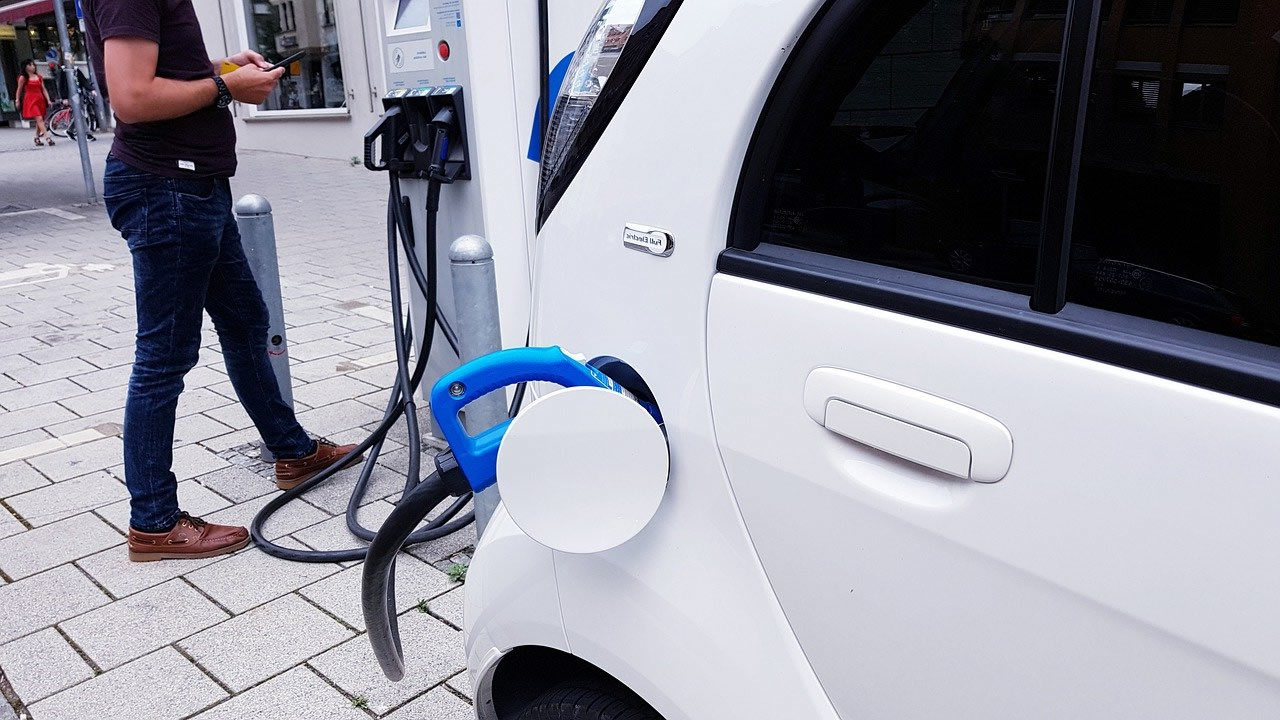
CO2 is removed from your holding tank as your car charges.
|
Your car will be a Carbon Capture Car.
It runs on batteries and captures CO2 as you drive from Point A to Point B.
This is also the blueprint for a vast scale enterprise to reverse a warming globe.
Turn the tables on Carbon Dioxide. Charge your car at the charging station, and the CO2 your car gathered from thin air since your last visit will be removed at the same time.
A small CO2 holding tank in the undercarriage of your car will fill and be emptied in an endless cycle. You won't even know it's happening. Carbon Dioxide or CO2 is odorless, non-toxic and non-combustible.
Imagine scrubbing the atmosphere of its most ubiquitous greenhouse gas—with the power of 1.5 billion vehicles all over the world performing this task. This is a win/win technology that might change everything. |
|
|
|
|
|
|
|
|
Carbon Polluting Car
Runs on
dangerous
fossil fuels |
|
Carbon Neutral Car
Runs on
batteries or Hydrogen
|
|
Carbon Capture Car
Runs on
batteries or Hydrogen |
Produces
and
emits CO2. |
X |
|
Emits
zero
CO2. |
|
|
Emits zero CO2 and routinely scrubs CO2 from the atmosphere. |
|
| 3 Red Cars - Images by Mohamed Hassan from Pixabay |
Vehicular CO2 Capture and Storage
... or, much easier to remember...
"Carbon Capture Cars" or even more simply... "CCC"
|
|
|
 |
|
"But what if you could
have a
personal-sized carbon capture
machine
on your car, airplane
or solar-powered home?" PBS |
"Renewable energy alone is not enough to turn the tide of the climate crisis. Despite the rapid expansion of wind, solar and other clean energy technologies, human behavior and consumption are flooding our skies with too much carbon, and simply supplanting fossil fuels won’t stop global warming. To make some realistic attempt at preventing a grim future, humans need to be able to physically remove carbon from the air."
|
|
|
Climate Change is real.
Let's ask that cars change to meet the challenge.
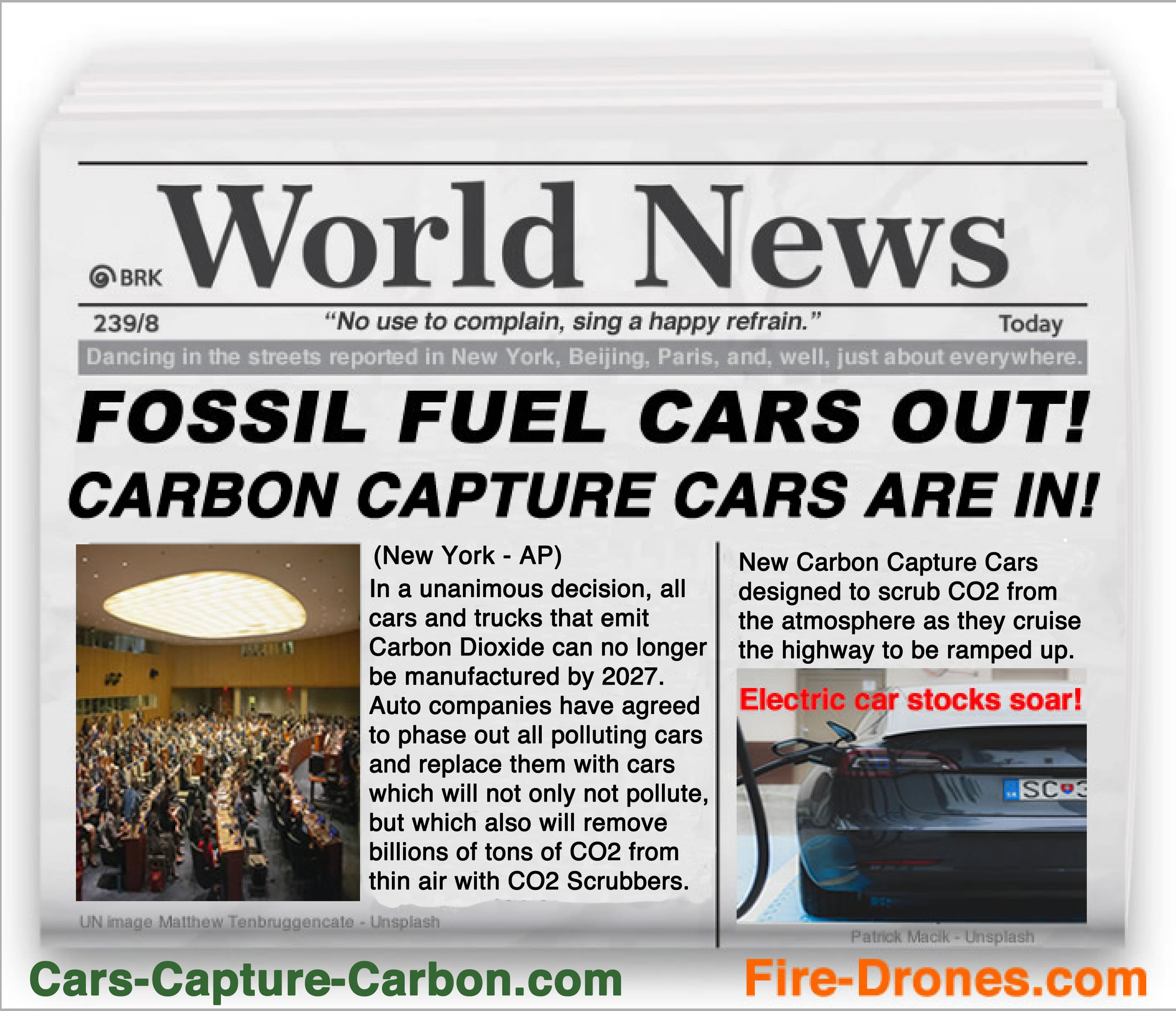
"World News" Image by OpenClipart-Vectors from Pixabay
TRANSLATION TEXT: Fossil Fuel Cars Out! Carbon Capture Cars Are In! (NEW YORK - AP)
In a unanimous decision, all cars and trucks that emit Carbon Dioxide will no longer be made by 2027.
Auto companies have agreed to phase out all polluting cars and replace them with cars
which will not only not pollute, but which also will remove billions of tons of CO2 from thin air with CO2 Scrubberrs.
New Carbon Capture Cars
designed to scrub CO2 from the atmosphere as they cruise the highway to be ramped up. Electric car stocks soar!
|
We don't need to invent or produce
exotic platforms to scrub the sky
of its CO2.
We can tap the vast infrastructure we already have...
|
 What if every car, truck, bus, RV, big ocean-going ship, and locomotive in the world was continuously removing gigatons of CO2 from the sky 24/7/365?
What if every car, truck, bus, RV, big ocean-going ship, and locomotive in the world was continuously removing gigatons of CO2 from the sky 24/7/365?
|

What if every car, truck, bus, RV, big ocean-going ship, and locomotive in the world was continuously removing gigatons of CO2 from the sky 24/7/365?
Let's replace all vehicles on the road—cars, buses, trucks, and RV's—with brand new Carbon Capture Car (CCC) designs.
An electric or Hydrogen powered CCC vehicle—charged of course only from non-polluting sources—would not only not pollute, it would also remove CO2 from the atmosphere as it went from here to there.
———— Carbon Capture Cars ————
Consider the raw power of
1.5 billion vehicles continuously extracting CO2 from the sky. This is 'Negative Emissions' tech taken to the limit.
Overwhelming scale will remove CO2.
Global auto infrastructure will lower cost.
We would be piggy-backing on the largest mobile human-made infrastructure available: all of the world's vehicles. This solution could be up and running quickly as manufacturers complied with new and binding statutes.
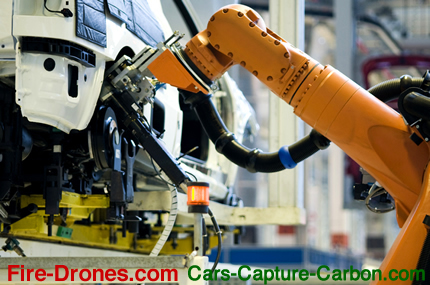
A CO2 Scrubber could soon be installed in every car or truck on the assembly line.
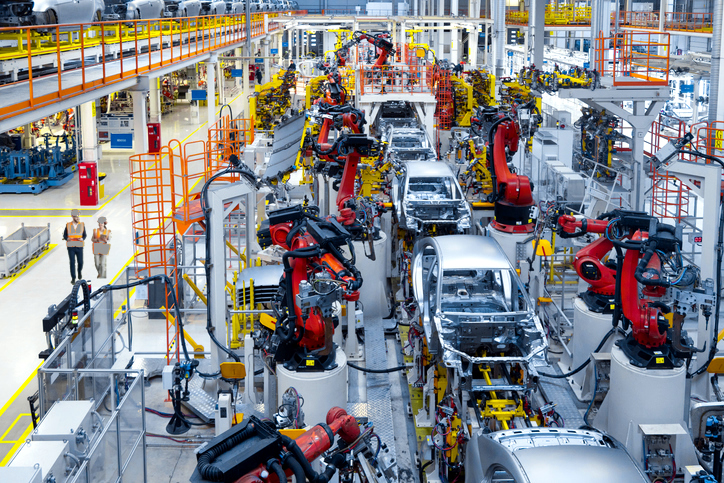
Speed, Efficacy and Overwhelming Scale
The advantages to tapping the world's vehicles as a potent CO2 reduction platform are many.
Its features include instant global scale, an active existing manufacturing platform to produce CCC vehicles, deployment within the briefest of timeframes, conversion of all gas stations into dual-purpose charging/CO2 accumulation facilities, and a potential for the removal of truly significant amounts of CO2 from the atmosphere with every passing year.
Learn about a new company, Verdox, which is making enormous strides in atmospheric carbon capture technology.
Faradaic Electro-Swing Adsorption
for High Efficiency Carbon Capture
An amazing new innovative Carbon Capture device can remove Carbon Dioxide from thin air—anywhere, and at any CO2 concentration.
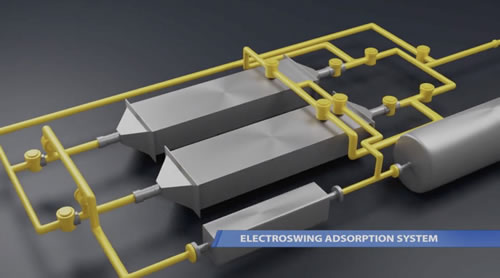
MIT • Energy and Environmental Science • Researchers: S. Voskian / T. Alan Hatton
BLOOMBERG VIDEO • CLICK THE PIC.
Watch a short video of how it works. The video depicts implementation of the system at grimy and plainly polluting smokestacks. To be sure, the technology might also work brilliantly in all of our 1.5 billion cars, trucks, buses, trains, skyscrapers, and big ships—and it will remove all of the billions of tons of CO2 we can't see.
This CO2 capture appliance might be the first step in a program to reverse Climate Change. The system is extremely efficient in its mission to remove only CO2 from the atmosphere.
Could that tech be adapted to our cars?
It's a possibility worth investigating.
Can it be tasked with capturing the air blasting in from the road at 70 MPH / 120 km/h., separating out the CO2, and then moving that CO2 to an adjacent holding tank for instant storage—until that CO2 can be delivered to the next electric charging facility or chargepoint??
A solid-state faradaic electro-swing reactive adsorption system in action:
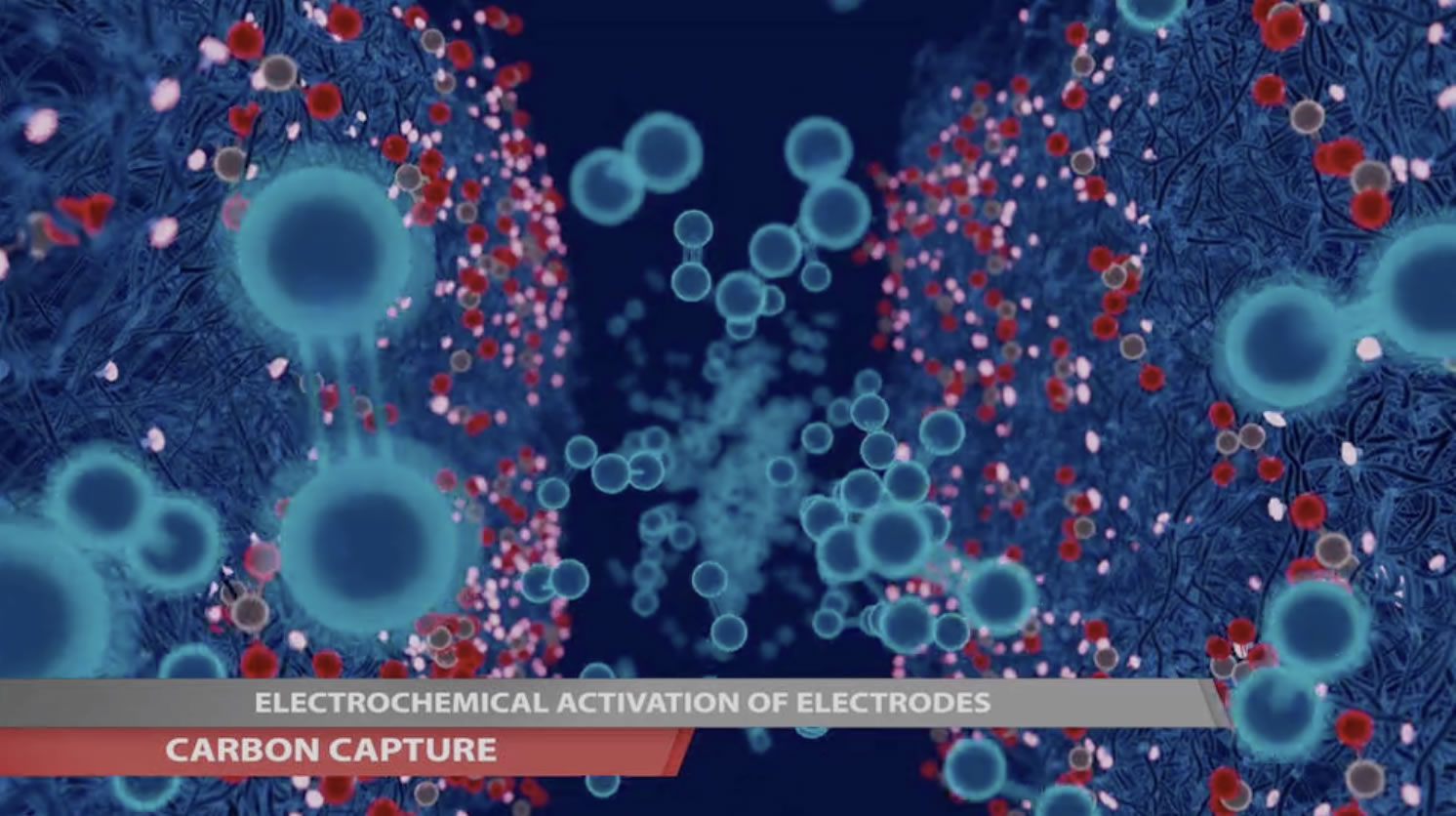
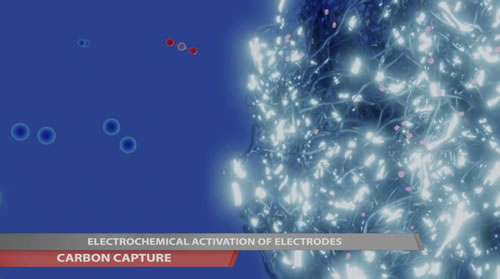
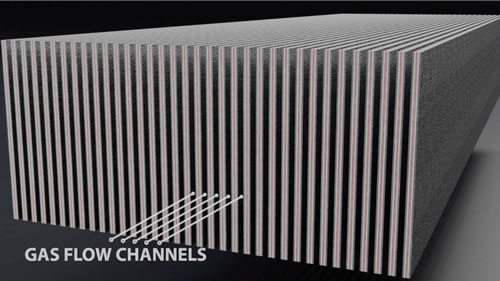
MIT • Energy and Environmental Science • Researchers: S. Voskian / T. Alan Hatton
"Relative to current technology, this electroswing adsorber could be retrofitted onto smaller, mobile sources of emissions like autos and planes, the study states." PBS
CO2 Scrubbers would be produced worldwide—and precisely where they are needed—in every automobile factory. Doing so allows for production targets to be met, and insures ongoing technical improvements.
Vehicles and their CO2 Scrubbers would then meet and begin their mutually beneficial partnership on an existing production line.

CO2 Scrubbers won't add an iota
of
CO2 pollution to the atmosphere.
CO2 Scrubbers are powered by a vehicle's onboard batteries; those would be charged only with clean electricity not derived from fossil fuels, just as would the electricity that powers the car's electric motors and systems.
Wherever you park, charging stations and chargepoints will deliver energy to your car's batteries. The energy to power your vehicle would be derived strictly from wind and solar.
Systems will be designed to re-capture as much energy as possible: For example, even heading down a hill will pump charge back into the batteries, which can then continue to supply regenerative power to the Scrubbers.
Auto manufacturers will be bound by new legislation to manufacture both CO2 Scrubbers and all the energy to produce their vehicles in their respective factories utilizing only solar and wind energy... just as every industry everywhere will soon be asked to do as well.
Implementation velocity is an essential dynamic for any serious global climate remediation endeavor. We can invite our vehicles to rise to this noble challenge.
The speed with which this powerful Climate Emergency solution could be implemented is one of its most remarkable promises: with a focused and concerted effort, that mobilization timeline could easily be five years or less.
"But what if you could have a personal-sized carbon capture machine on your car, airplane or solar-powered home?"
PBS • THE NEWS HOUR |
Let's drive the world clean...
Phase out production of CO2 polluting vehicles in the world over five years—and replace them with vehicles that do just the opposite.
New vehicles remove gigatons of CO2 from our atmosphere by employing a potent technology on a platform that is already at global scale.
It's simple...
All vehicles will have an onboard CO2 storage tank. Tanks on cars will be small, and those on trucks and buses will be larger. As a vehicle travels, outside air is forced against its CO2 gateway. Only CO2 is let in. With every drive, we'll capture as much CO2 as possible.
We would also take advantage of every vehicle's need to recharge: accumulated CO2 is delivered to receptacles at charging stations.
You plug in for your Hydrogen or electric charge—and utilizing the same nozzle—CO2 would be drawn out of your CO2 capture tank. That CO2 then is sent away for sequestration: it is stored where it can do no further damage.
That CO2 could be injected deep underground, delivered to storage silos via pipeline, or even transported to a sequestration destination by jumbo Green tanker trucks—also running on clean electricity or Hydrogen—similar to the ones that once delivered gasoline and oil.
This real-world innovation would utilize the 'Commitment to Scale' principle to the maximum degree. It could easily be launched globally within as brief a period as 5 years.
That we can redesign our cars, trucks, buses, trains, recreational vehicles, skyscrapers and big ships to reverse Global Warming might seem strange at first. After a while though, as you realize the unlimited potential, you may find yourself saying "Of course, of course..."
Our cars will engage their vital mission for three decades. Slowly but surely, all the excess CO2
pumped into our fragile global atmosphere will be removed.
The work to develop this technology such that it will perform ideally when installed in hundreds of millions of cars and trucks will require an unprecedented effort by teams of of scientists and engineers.
That work can be supported by legislation—and billions of public dollars— to produce a working, replicable, safe and potent CO2 Scrubber design that car manufacturers could readily implement.
When CO2 in the sky drops to pre-industrial levels, only then will factories stop adding CO2 removal devices to a car or truck's chassis.
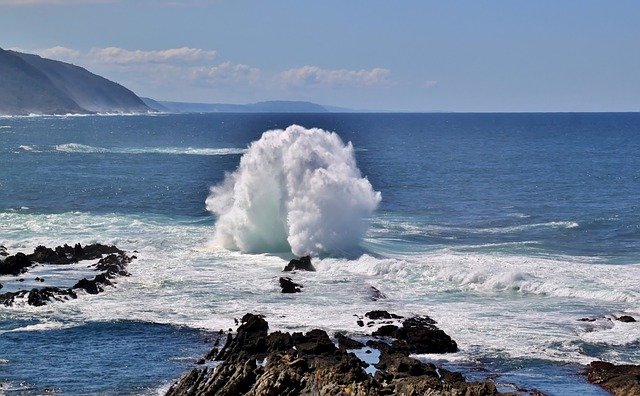
Image by Anja #helpinghands #solidarity #stays healthy from Pixabay
Carbon Capture Cars
can save our oceans too...
Why might we need to go even lower than pre-industrial CO2 concentrations? The oceans are also warming, and solutions to ameliorate those dynamics may be harder to come by.
SCIENTIFIC AMERICAN
Fossil fuel burning releases CO2 into the sky. Half stays aloft, a quarter is taken up by plants and trees, and a quarter gets dissolved in the ocean. When there is more CO2 in the ocean than in the sky, the ocean releases that CO2.
NOAA
With efficient atmospheric CO2 removal by our cars, we will have a global thermostat which can compensate for those warming seas, by removing the excess CO2 they release into the atmosphere. A global CCC fleet of vehicles can effectively clean the sky... and the seas too!
New methods for the sequestration of CO2 are now available, based on a technology able to remove CO2 from the atmosphere at any concentration.
Adsorption is the temporary sticking of gas molecules to a surface engineered to do that.
Stage One: The inside surface of the Electro-Swing Adsorption System is designed to 'catch' ONLY CO2—and the clinging of that CO2 to that surface is intended to be brief.
That pause allows us to separate the CO2 from everything else in a stream of ordinary air. It lets us then concentrate that CO2 as well.
All gases other than CO2 are flushed out of the system and returned to the atmosphere.
Stage Two: Following that expulsion, the pure captured and concentrated CO2 is released into the clean environment of a holding tank, completing this stage of the cycle.
Finally, the Carbon Dioxide is piped or trucked away to permanent sequestration facilities.
That may not sound like a big deal.
But is it possible that developing this process so we can install it in cars, trucks, buses, ships, locomotives and skyscrapers might just provide us with the powerful tools we will need to make a major difference in reversing Climate Change— if we can implement it at global scale, and in a timely manner?
<––––––––––––––––––– A simulated electron microscope close-up allows us to understand the process.
The red and grey molecule represents CO2 being momentarily yanked from the stream of gases, and adsorbed by the system's electrified fiber array. At the same time, the light blue feed gas—in this image O2 or Oxygen—continues pushing everything that is not CO2 along.
<––––––––––––––––––– With the exit channel now cleared, the next stage of the electro-swing cycle releases that momentarily captured CO2 from the adsorption matrix—those bright white electrified patches.
What then is ejected is importantly a stream of nothing but pure Carbon Dioxide.
That ejection of CO2 is temporarily stored in a holding tank, and then delivered to a facility where it is sent on its way to be sequestered deep underground for millennia to come.
<––––––––––––––––––– This enlargement of the interior of the Electro-Swing apparatus shows where ordinary air is drawn into the device to then begin the separation process.
Theoretically, the adsorption matrix can capture CO2 at virtually any concentration.
"A new way of removing Carbon Dioxide from a stream of air could provide a significant tool in the battle against Climate Change. The new system can work on the gas at virtually any concentration level, even down to the roughly 419 parts per million currently found in the atmosphere." SCIENCE DAILY
"The device is essentially a large, specialized battery that absorbs Carbon Dioxide from the air (or another gas stream) passing over its electrodes as it is being charged up, and then releases the gas as it is being discharged.
In operation, the device would simply alternate between charging and discharging, with fresh air or feed gas being blown through the system during the charging cycle, and then the pure, concentrated Carbon Dioxide being blown out during the discharging." SCITECHDAILY
"Of course, the real game-changer here is that the technology can be retrofitted for smaller devices and does not require a high density concentration of carbon to be efficient. This is nothing short of a breakthrough step in carbon capture technology." FORBES
And a quote from the inventors of this novel cleansing system: "We demonstrate a new approach which presents a paradigm shift in adsorption type processes and Carbon capture." ENERGY & ENVIRONMENTAL SCIENCE
There are many good people dedicated to action regarding CO2 proliferation — whom, with the best of intentions — see our cars as a threat to our survival, rather than as a uniquely viable platform to save the planet. Let's invite those folks to consider this plan.
The current world-wide car fleet is indeed a grave threat to our survival; it is the proverbial elephant in the room. But if we can mobilize quickly and declare that the day of the polluting car is over, and that the age of the Carbon Dioxide Capturing Electric Car or Truck has arrived, we will reverse course.
Carbon Capture Cars, trucks, buses, RV's, etc., are coming to a showroom near you.
Let's spread the word, and let's share the science behind it:
There is no more profound nor potent global platform than 1.5 billion 'machines' — surging on their way to 2 billion of them— all over the world removing Carbon Dioxide from the sky 24/7/365 for 30 years.
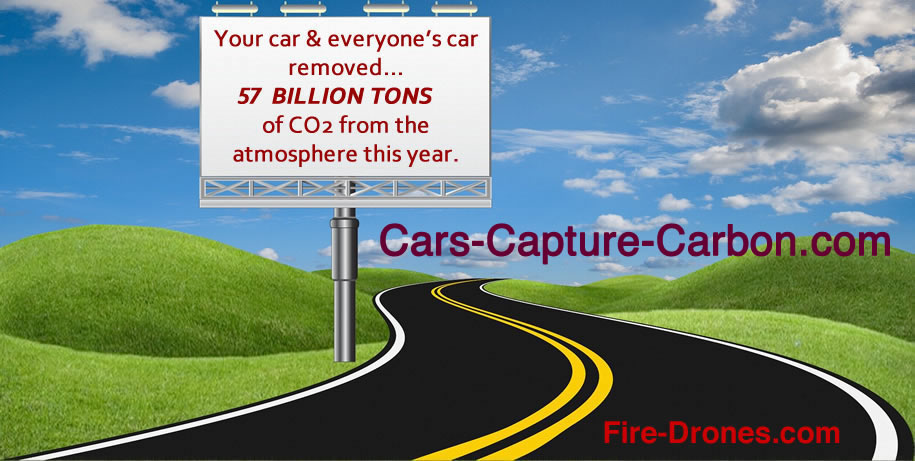
Your car & everyone's car removed...
57 BILLION TONS of CO2
from the atmosphere this year.
|
|
|
|

Let's make these our primary Climate goals:
• STOP blasting CO2 into the atmosphere,
• REMOVE all excess CO2 from the sky,
• CONCENTRATE that CO2 ... and then ...
• SEQUESTER it deep below ground— forever.
|
|
To be maximally successful
at
global-scale CO2 removal,
cars and all vehicles will be
designed to have
almost zero
downtime
in their pursuit
of carbon capture directly
from the atmosphere.
They will be on the job 99% of the time. |
We would continue to efficiently remove atmospheric CO2 even when we're not driving anywhere.
Doing so would not necessarily involve running the vehicle's motors, nor tapping its batteries.
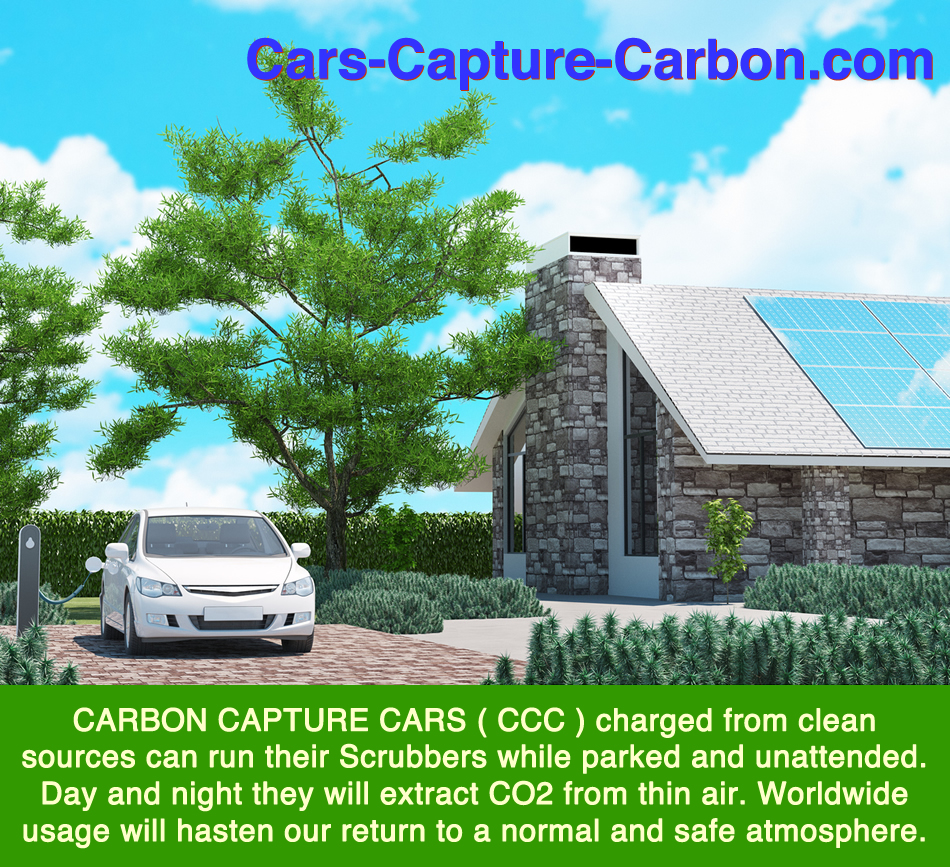
Image text translation: CARBON CAPTURE CARS ( CCC ) charged from clean sources can run their Scrubbers while
parked and unattended. Day and night they will extract CO2 from thin air. Worldwide usage
will hasten
our return to a normal and safe atmosphere. |
|
| |
|
With what other atmospheric CO2 reduction enterprise could you promote a road map
for One Billion Five-Hundred Million large and powerful machines to continuously remove Carbon Dioxide from the sky day and night — everywhere — involving everyone — and doing it easily and cost-effectively for decades to come? |
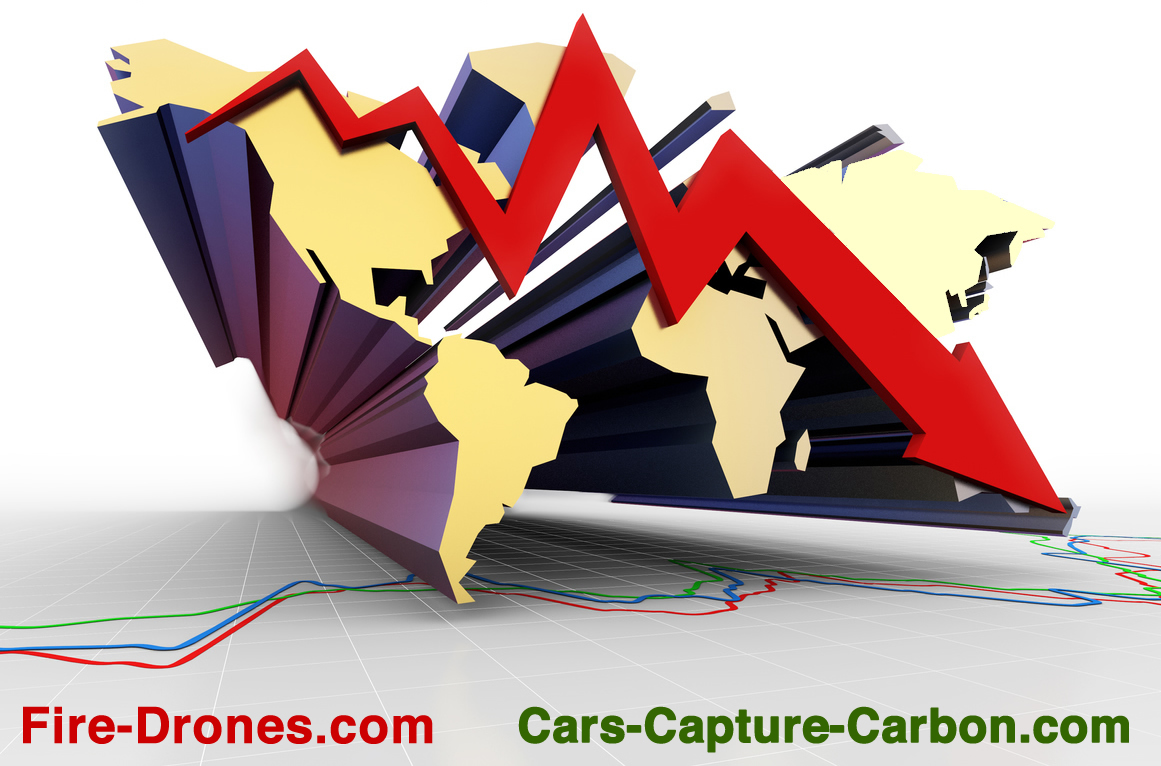
The red arrow symbolizes the dynamic rate of Carbon Dioxide removal from our atmosphere
by outfitting all vehicles, ships and large buildings with the ability to remove CO2 from the sky.
|
|
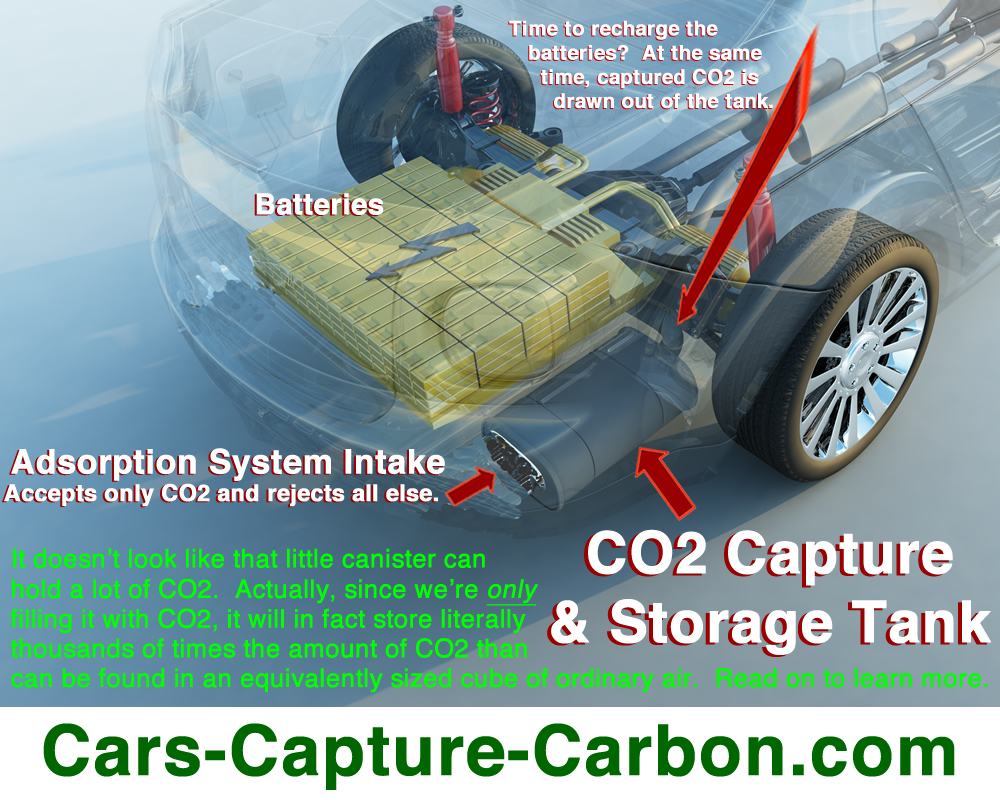
Image text translation: Time to recharge the batteries? At the same time, captured Carbon Dioxide is drawn out of the tank. Batteries.
CO2 Capture and Storage Tank. Adsorption System Intake: Accepts only Carbon Dioxide and rejects all else. It doesn't look like that little
canister can hold a lot of Carbon Dioxide. Actually, since we are only filling it with Carbon Dioxide, it will in fact store literally thousands of
times the amount of Carbon Dioxide than can be found in an equivalently sized cube of ordinary air. Read on to learn more.
|
Onboard tanks store CO2 plucked from thin air, until your vehicle is recharged.
Image: The clean energy charge goes in, and the Carbon Dioxide drawn from the sky goes out to be sequestered far away.
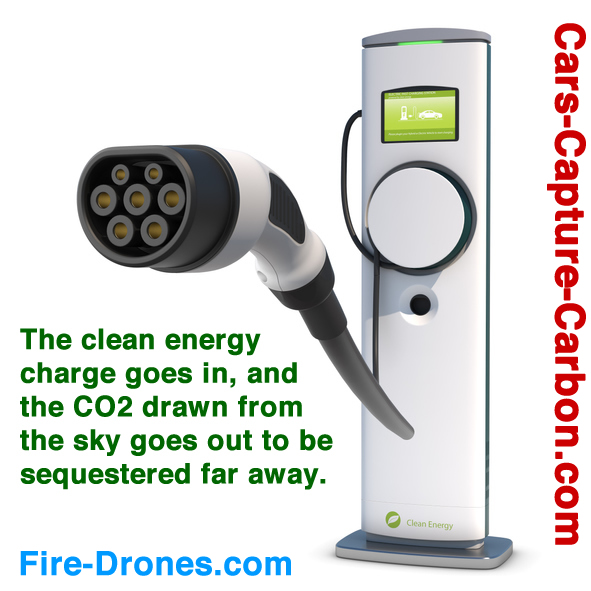 When you stop at the charging station, your accumulated CO2 is drawn off. It won't require you to do anything. When you stop at the charging station, your accumulated CO2 is drawn off. It won't require you to do anything.
When the novelty wears off, you'll forget it's even happening. The nozzle that delivers your electric charge will also withdraw the CO2 your vehicle has collected since the last visit to any station.
Your onboard CO2 tank does not need to be big. Depending upon the size of your car, it might hold 2 to 4 cubic feet of highly concentrated Carbon Dioxide gas.
Tank size will also depend on how big a tank your vehicle can accommodate. For a car, that would be smaller. For an RV, large truck or bus, the tank might be double or quadruple in size. Locomotives and ships have enormous capacities for tanks.
You can get a much better idea of the air cleansing power of a properly outfitted CCC vehicle below—and let's think inside the box for a change.
Your new Carbon Capture Car will remove all of the Carbon Dioxide
in this volume of air—and it will do it every week... |
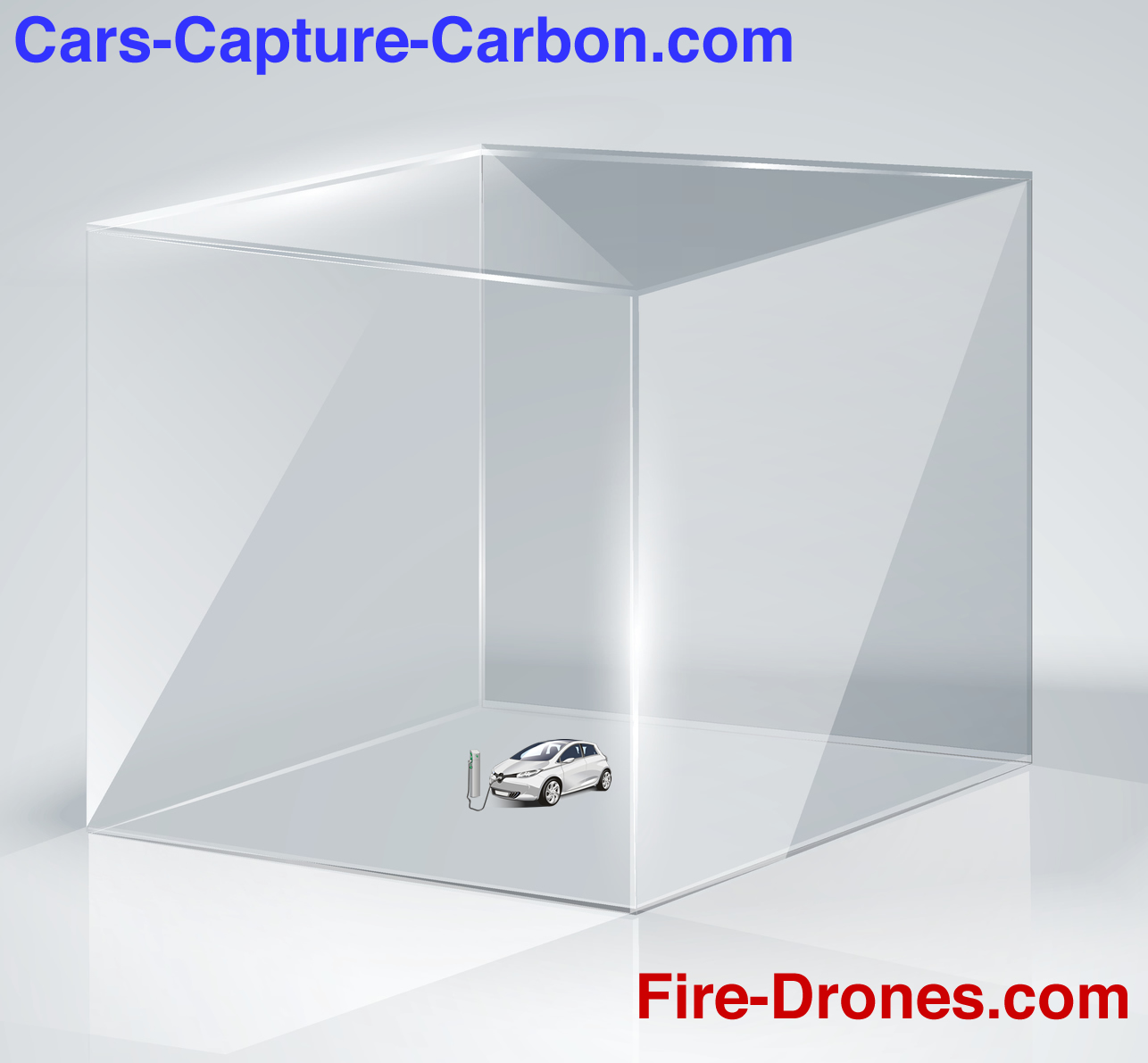
Electric or Hydrogen Automobile •
Image by Francis Ray from Pixabay • Cube Image by istockphoto
Imagine if every car, truck, RV, bus, locomotive, big ship and tall building in the world is also removing all of the CO2 in its own cube of air—and it is doing that continuously, year after year—until our sky is once again clean and pristine.
 On average, vehicles would do it once a week: they would empty their accumulated CO2 at the same time as they recharge at any EV chargepoint. Large vehicles would have larger tanks. Tanks on trucks, buses, locomotives and large ships would clear CO2 out of much larger volumes of air. On average, vehicles would do it once a week: they would empty their accumulated CO2 at the same time as they recharge at any EV chargepoint. Large vehicles would have larger tanks. Tanks on trucks, buses, locomotives and large ships would clear CO2 out of much larger volumes of air.
The description of there being a volume of air for any given vehicle is just a way for you to visualize the extraordinary impact this new technology will have on the total atmospheric shell which surrounds the earth. Naturally, all volumes of air are constantly churning and mixing with each other.
 An internal combustion engine car on the road emits about 4.6 metric tons of Carbon Dioxide each year. EPA A CCC car will remove a healthy percentage of that every year. An internal combustion engine car on the road emits about 4.6 metric tons of Carbon Dioxide each year. EPA A CCC car will remove a healthy percentage of that every year.
CCC vehicles will extract CO2 tirelessly for the next 30 years—in conjunction with a host of other potent CO2 cleansing methods—until the percent of CO2 in our atmosphere is at levels not seen since the Industrial Revolution of 1760. That was the point at which industrial pollution of the sky began.
Image to the above right by Léonard Defrance - Interior of an Industrial Revolution Foundry.
If you are scratching your head, and thinking:
"How can you put that much CO2 in a small tank?"
The amount of CO2 in any given atmospheric cube of air—even a really big cube—is not very much.
  Remember that the percentage of CO2 in any given volume of ordinary air is miniscule. Scientists measure that percentage in 'ppm,' or 'parts per million.' Remember that the percentage of CO2 in any given volume of ordinary air is miniscule. Scientists measure that percentage in 'ppm,' or 'parts per million.'
The amount of CO2 in the cube depicted here is 421 ppm. That percentage of CO2 occupies a mere .04% of the cube. Please note— that's not 4%, and it's not .4%. It's .04%— a teeny, tiny, miniscule amount of Carbon Dioxide.
This much are other gases: 999,584 ppm, or 99.96%!
Mulitply that one cube's weekly cleansing by the 1.5 to 2 billion Carbon Capture Cars that will be on the road, with each one removing all of the CO2 in their cube— and then multiply that by 30 years of effort.
"I've heard that Carbon Capture can be an expensive process.
What's the truth about that? Is there a way around that expense?"
Carbon Capture can be a relatively expensive process.
In the scenario being presented in this report, the feared costs associated with Carbon Capture in general, and Carbon Capture Cars in particular, will be mitigated by overwhelming scale at every level.
MIT researchers have already produced laboratory versions of a game-changing atmospheric Carbon Dioxide extraction device. Their invention differs from other similar initiatives in that it is designed to extract airborne Carbon Dioxide at any concentration. That might not sound like a groundbreaking ability—  but it is in fact so revolutionary that 'We the People' need to support this particular effort whole-heartedly, as its implications for our survival as a civilization might hinge upon this very technology. but it is in fact so revolutionary that 'We the People' need to support this particular effort whole-heartedly, as its implications for our survival as a civilization might hinge upon this very technology.
Continuing intensive research by the company they've founded, and the scientific teams they will employ, will greatly optimize the CO2 Scrubbers destined to be installed in our cars, trucks, buses, etc., so that those scrubbers are both powerful and affordable; 650 or so automobile factories around the world will streamline their production; and, at least for this particular device, they might just all utilize the same design, and once again bring costs down because of it.
Automobile manufacturers will pool their purchasing power to inexpensively requsition raw materials.
The devices they produce in their factories will be cost-effective due to high production line efficiencies, the sheer scale and quantity of CO2 Scrubbers being manufactured on those production lines, and—given the planet-saving nature of the goal—the financing governments will contribute to defray costs.
Should vehicle owners be concerned about Carbon Capture costs??
Models for the cost of Carbon Capture range from 'affordable' to 'off-the-charts.' The MIT researchers indicate that their electro-swing device in operation would cost about $50 to $100 US Dollars per Metric Ton. That's in the affordable range. Still— could we do better? Let's consider the "Fair Share" approach.
In regards to Carbon Capture Cars, those costs wouldn't be demande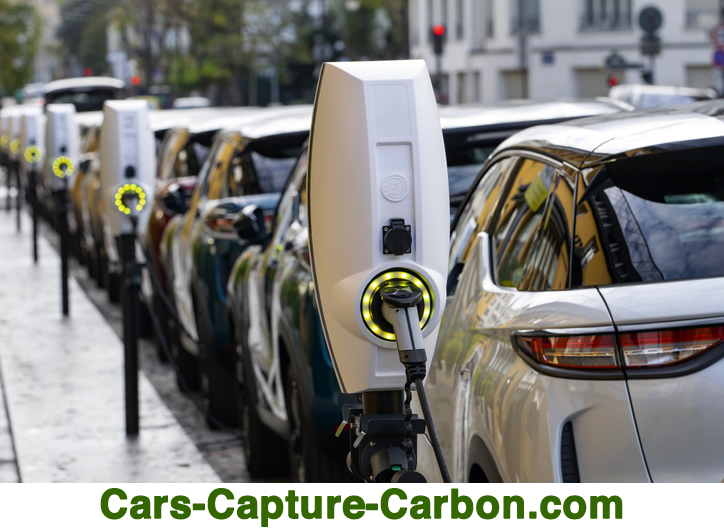 d of individual car owners. In the same way sewer systems are paid for by a municipality—with everyone paying their fair share in the form of taxes, and for a service that everyone ultimately uses—any nation's vehicle fleet will likewise be included in an overall public tax for the costs of capture, the conduits for that captured CO2, and the eventual sequestration of that Carbon Dioxide 7,000 feet deep below the earth's surface. d of individual car owners. In the same way sewer systems are paid for by a municipality—with everyone paying their fair share in the form of taxes, and for a service that everyone ultimately uses—any nation's vehicle fleet will likewise be included in an overall public tax for the costs of capture, the conduits for that captured CO2, and the eventual sequestration of that Carbon Dioxide 7,000 feet deep below the earth's surface.
The market will be involved, and meaningful legislation will ensure that Carbon Capture Cars—and all vehicles that will utilize the tech—will conform to every possible vetted plan to guarantee that the car and the device affordably meet. Remember that first and foremost, capturing skyborne CO2 is society's goal, not just the vehicle owner's assigned task.
In the final analysis, whatever the ultimate cost is regarding a technology which promises to reverse Climate Change in relatively short order, that commitment far exceeds the alternative: that doing nothing—or just not doing enough—will be infinitely more expensive—as well as dangerous for a planet already reeling from atmospheric CO2 proliferation.
To succesfully implement Carbon Capture Cars globally,
nations will do what it takes to
achieve a successful outcome
regarding cost,
as the alternative is just too unthinkable.
___________________________________________________________

|
There are two ways to look at CO2:
1. How much more CO2 is in the sky today,
compared to natural pre-industrial levels?
2. What is the percent of CO2
in the sky
today, compared to the total volume of air?
|
| |
Here's why understanding this is important: The answer to those two questions are as different as day from night, even if it would seem that the answers might be similar.
It is crucial to understand the distinction, if we also want to understand why
Carbon Capture Cars will work when they are tasked with CO2 removal
from the ocean of air in our vast one billion cubic mile atmosphere.
|
| |
|
|
How much more CO2 is in the sky today, compared to natural pre-industrial levels? |
|
What is the percent of CO2 in the sky today
compared to the total volume of air? |
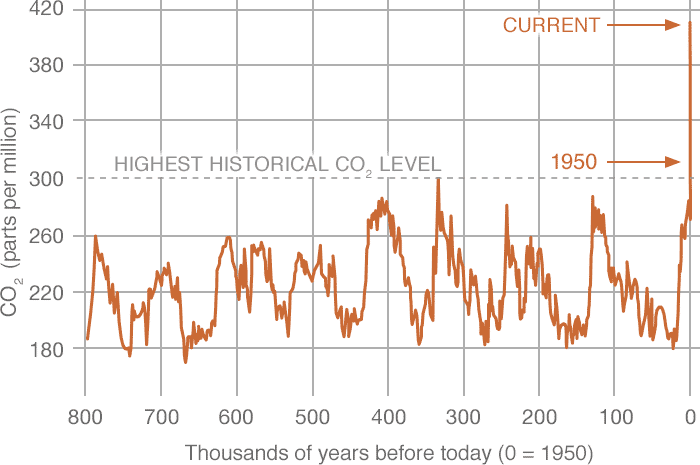
The current level of atmospheric CO2 is 419 PPM. For thousands of years, the pre-industrial levels oscillated between 180 and 300 PPM. Somewhere around 1950, the CO2 level count took off dramatically. NOAA
Concurrent with that huge 120 PPM increase from 1950 to today, atmospheric heat has exploded due to the profound heat-trapping nature of skyborne Carbon Dioxide.
In today's world, everyday more CO2 is added to the sky than is removed by natural processes. |
|
Now, here is the core principle which allows cars to capture meaningful amounts of CO2:
Percentage-wise, there is very little Carbon Dioxide in the sky, relative to all the other gases in any given volume of ordinary air, even though our civilization has more than doubled the amount of Carbon Dioxide in the atmosphere since the pre-industrial era.
That doesn't mean that there isn't a lot of CO2 in the sky.. there surely is.
CO2 capture tanks can be small because the CO2 our cars will capture every week will now be highly concentrated:
that means we will stuff an awful lot of CO2—and nothing but CO2—into a small tank on our car's undercarriage.
Whenever you stop to charge up, the CO2 in your tank will automatically be drawn off to be sequestered below impervious geologic formations located 7,000 feet underground.
Consider also that we don't have to remove all of the CO2 in the atmosphere; we just have to remove somewhere in the vicinity of half of it. |
| |
|
|
The takeaways?
The ever growing amount of CO2 in our sky will cause average global atmospheric heat levels to increase everywhere on Earth for many years to come; but importantly, notice that the percentage of CO2 in
the sky will remain miniscule. |
|
That provides our avenue of attack and invites the
most potent way out of our existential dilemma:
Scrub the sky clean of its excess CO2 with our cars. |
|
| That is good news and our saving grace.. it means we can implement powerful new atmospheric CO2 removal technologies in planet-saving rates of time. |
|
Finally, all the projections for effective, massive and rapid CO2 removal by billions of cars, trucks, trains, ships, tall buildings, etc., depend upon one other very important factor:
We mustn't fail at implementation of a contract with the planet that supports all of our needs.
The opening paragraph of that document will say:
"The
introduction of planet-killing
Carbon Dioxide into our atmosphere must stop...
That is Job #1 as a civilization." |
|
|
Cars-Capture-Carbon.com • Fire-Drones.com
|
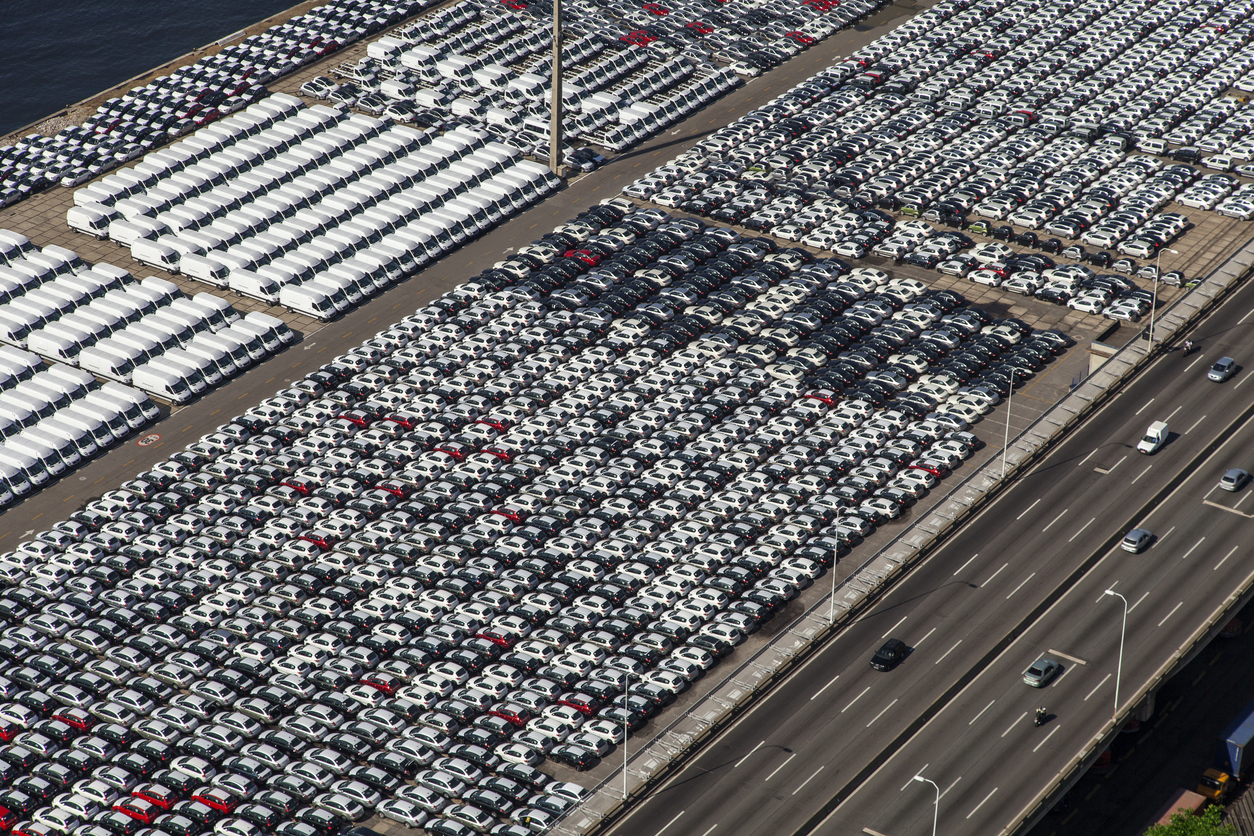
There are about 1,500 new Carbon Capture Cars and trucks on that shipping dock.
It sure looks like a lot of cars... but be bold and imagine them multiplied to the actual projected numbers: a global fleet of 1.5 to 2 billion CCC cars removing CO2—every minute of every day—from thin air as they cruise around town or take to the highway.
Effectively tackling Climate Change is always all about embracing massive Scale.
|

Translation: 1.5 billion CCC cars. Take a deep dive into how much climate disaster reversing power they promise, and let it sink in.
> Every dot represents one CCC car. <

Could our new
CO2-Scrubber equipped Carbon Capture Cars — along with all the other CCC vehicles on the road — quickly remove all of the dangerous excess Carbon Dioxide from our highly contaminated atmosphere?
Could we completely reverse Global Warming——— without relying on any other method? This plan fits the bill.
Our goal is to build 1.5 billion CCC cars. Each dot represents one Carbon Capture Car, every small square 100 cars, and every large square with a wide white border, 10,000 cars.
PLEASE CLICK THIS BLUE LINE TO SEE FOR YOURSELF WHAT A BILLION CARS (Represented by Dots) LOOKS LIKE.
ALL of those cars are yanking CO2 from the sky day and night, for decades to come, on the road, in charging-equipped parking lots—or when your car is in your driveway.
Image Text Translation: "
Every dot represents one Clean & Green Carbon Capture Car. "
That presentation is 2 hours and 39 minutes long, but for our purposes, just a few minutes there will suffice.
Most of us have no idea what a billion cars look like, much less one billion five-hundred million, nor the two billion cars, trucks and buses projected to be on our highways in the coming years.
You'll be amazed, and you'll get a true feel for the climate-saving scale  and potential of our humble automobiles. Please go ahead... take just a few minutes to witness what an actual planet-saving paradigm shift really promises. and potential of our humble automobiles. Please go ahead... take just a few minutes to witness what an actual planet-saving paradigm shift really promises.
When it says "Dots," you think.. "Carbon Capture Cars."
About 150,000 cars are produced world-wide every day. With each of them joining those produced the day before, and the day before that, you can begin to appreciate the ramp-up speed of this powerful global CO2 remedy. Go ahead, click the pic above!
Please return to Cars-Capture-Carbon.com when you finish!
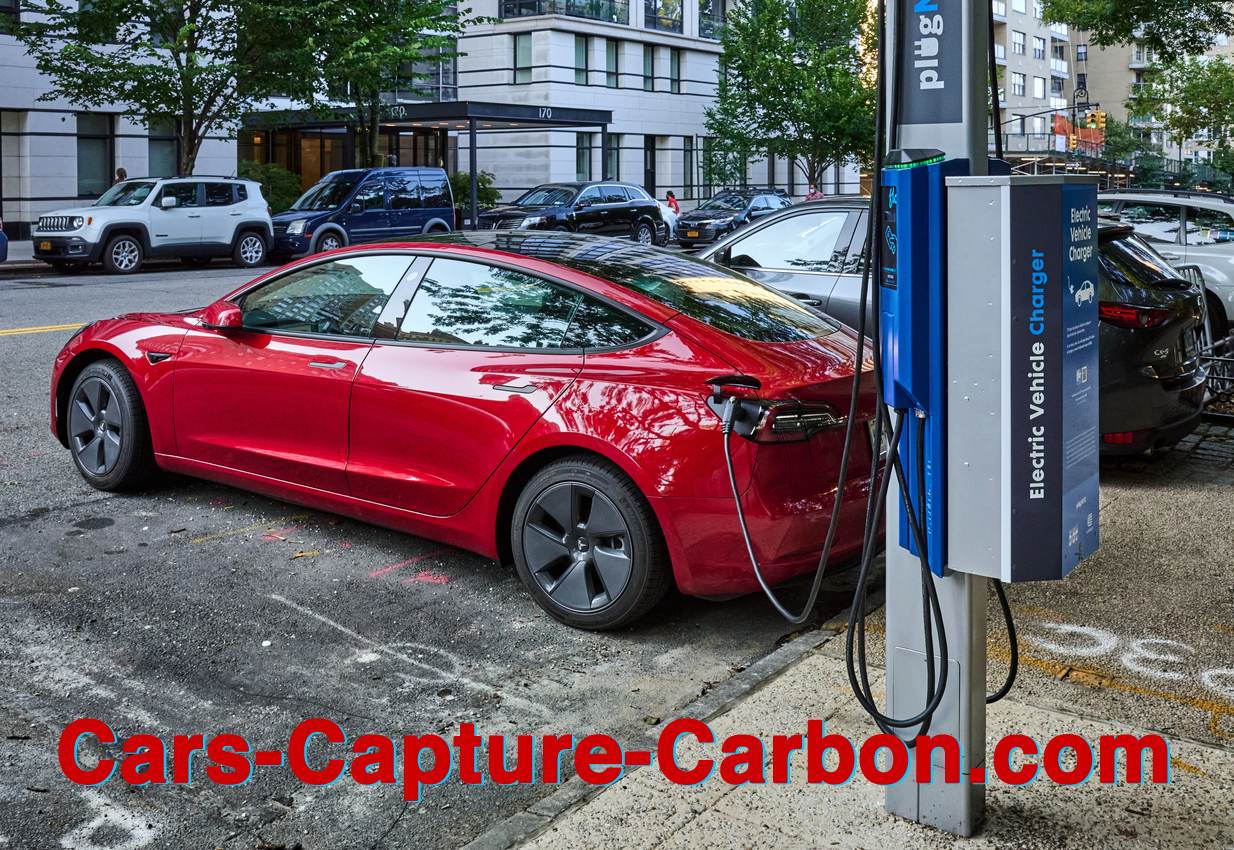 |
Clean Energy Available Anywhere
City blocks, commercial streets, Mall or beach parking lots, highway rest stops — almost anywhere you might park your car — will be designed to offer fast and affordable charging.
Carbon Capture Cars Deliver CO2
Every recharging station or curbside stand — wherever they might be situated — will also be equipped to draw off your accumulated atmospheric CO2, and send it to be sequestered deep underground — forever. |
|
Our timeline to reverse a scorched future:
2022: 78 million dangerous CO2 spewing cars, trucks, RV's and buses are produced worldwide.
2023 and 2024: The same bad news as 2022.
2025: A brand new batch of 78 million Carbon Capture Cars—abbreviated as CCC's—and includes cars, trucks, RV's, buses, etc., —no longer put any CO2 in our sky.
Instead, they begin to swiftly remove all excess atmospheric CO2 at global scale and meaningful rates.
2026: Yet another new batch of 78 million CCC's is delivered to excited motorists the world over.
The old polluting cars leave the road, or are retrofitted with new Carbon Dioxide scrubbers.
 |
With each passing year, millions of new CCC sky-cleaning cars are added to the roster, until the goal of one and a half billion of them is achieved. |
| Translation: BLUE: Global Temperature Change – ORANGE: No CO2 Emissions Cuts – GREEN: Substantial Cuts In CO2 Emissions |
Compared with oil and gas extraction, wind and solar cost, well, ... nothing. Wind and solar energy are free and abundant just about anywhere and everywhere on Planet Earth.
Yes, it's true we'll also need solar panels and wind turbines galore.
But, once installed, the cost of maintenance for that infrastructure – when compared to the dangerous and outdated current system – is extremely modest.
Wind and solar energy generation is ample, safe, reliable, and cost-effective.
By electrifying our global grid with only wind and solar 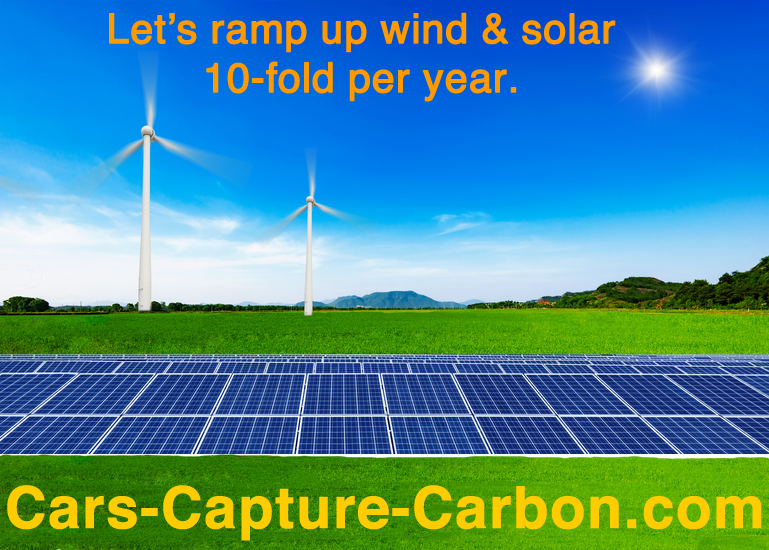 power, we will have a safe, affordable and stable supply of electricity for every purpose; and, most importantly, for propelling all of our Carbon Capture Cars. They will get us around— and secure a future for our planet. power, we will have a safe, affordable and stable supply of electricity for every purpose; and, most importantly, for propelling all of our Carbon Capture Cars. They will get us around— and secure a future for our planet.
Unlike the oil shocks we now regularly experience — caused by an unstable system charging wildly fluctuating prices for a product that is bad for our lungs and our health — and so much worse for the health of our global atmosphere — we will instead appreciate the safe consistency of a uniform and universal clean energy supply.
The oil industry itself might choose to get onboard with wind and solar.. and not as an ornament to hide the deleterious results of their petroleum-based platform, but as a new strategy to remain relevant.
OIL COMPANY INVESTORS DISMISS WIND & SOLAR

The only reason to not choose that route would be if the management of those companies — and their stockholders — actually believe that Climate Change is something that will bite us only in the far distant future, and we still have plenty of time to generate a few more billions.
They might consider that we are now losing in the bottom of the 8th inning, and that the optimal time to meaningfully change course is right now.
They could use their wide range of resources—and their scientists and engineers—to design and fund a complete transition to wind and solar. Everyone who works for these companies has kids too.
And what about our future on Planet Earth?
Will Carbon Capture Cars confidently move us forward??
With your support, the answer can be an emphatic 'YES!'
In just the next few years time, we could see our transformed global fleet of CCC vehicles beginning the reversal of Earth's atmospheric warming, and thus altering the destiny of a once imperiled civilization.
 With a World War II-style production mentality, governments and automobile manufacturers can—and must—secure this precious goal at lightning speed. With a World War II-style production mentality, governments and automobile manufacturers can—and must—secure this precious goal at lightning speed.
The New Partnership: CARBON CAPTURE CARS
& THE WORLD'S FORESTS
One hand washes the other... as Carbon Capture Cars begin to proliferate, they will remove greater total amounts of skyborne CO2 with every passing day, as more CCC vehicles are added to the fleet; and at the same time, polluting vehicles will leave the road or be outfitted to capture their own CO2 effluence. This will also slow and eventually reverse a warming atmosphere.
And, by lowering temperatures with atmospheric CO2 removal by Carbon Capture Cars, trucks, buses, trains, big ships, and skyscrapers, etc., our global forest range will be in much better shape because of it. And, by asking forests to continue their millennia of work capturing carbon to keep the Earth cool, all the coming potent technology to remove atmospheric CO2 overload will enjoy a powerful and timely helping hand.
_________________________________
What would power the CO2 Scrubbers integrated into every vehicle?
We may choose to have all vehicles run on efficient batteries that are charged by wind and solar sources only. Consider that little energy is required to deliver CO2 to the Scrubbers—it just blasts in as your car tools down the highway.
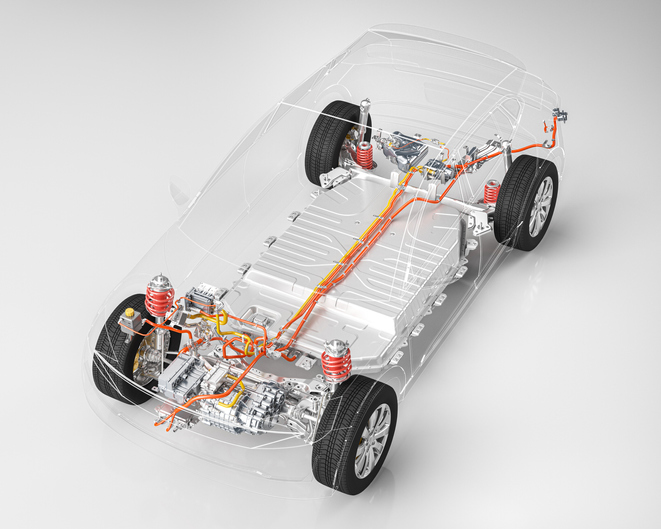 Energy will still be required to operate the Scrubber. Energy will still be required to operate the Scrubber.
That power will be sourced from the car's extensive complement of high energy-density batteries, and perhaps also be co-generated by unseen small but highly efficient compact wind turbines adjacent to the CO2 Scrubber.
The stark warnings now permeating the conversation that a new energy infrastructure will be required to remove all the excess CO2 up there—and it will call for thousands of huge facilities, at astronomical costs, and 50-year timelines—might now be obviated by the relatively low cost, simplicity, and raw power of simply asking our vehicles, trains, big ships, and even our tall buildings, to engage the task.
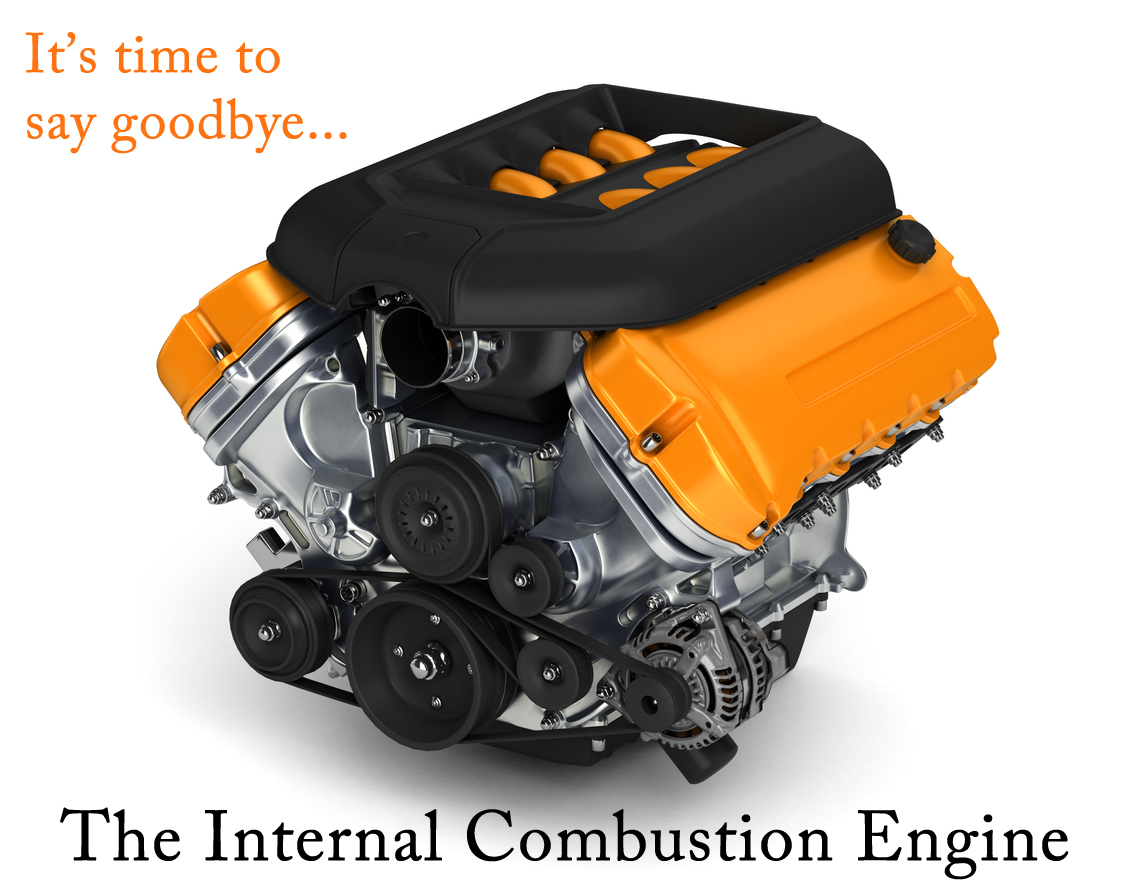
Image text translation: It is time to say goodbye... The Internal Combustion Engine.
Why couldn't we leave the internal combustion engine in place,
and just add CO2 Scrubbers on our vehicles?
Choosing that route would be better than doing nothing—but not by much.
The problem is that the world is careening towards an unimaginable future of heat, devastation and death—and much of that nightmare is caused by polluting cars, trucks, 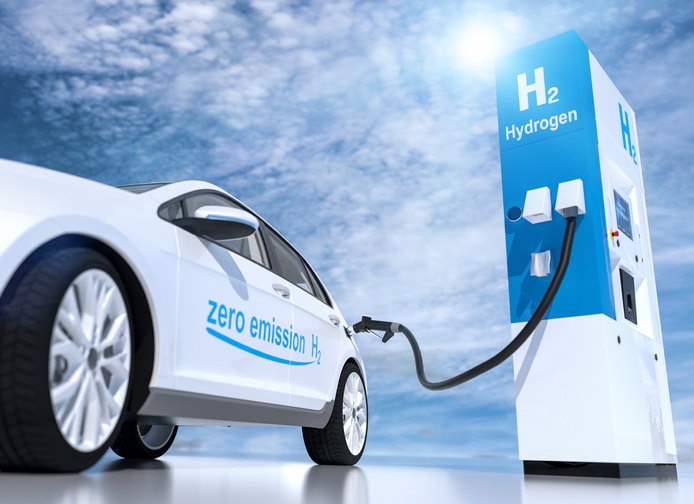 buses and large ocean-going ships. A reckoning for our folly is coming our way much faster than all previous evidence would suggest. buses and large ocean-going ships. A reckoning for our folly is coming our way much faster than all previous evidence would suggest.
Without maximizing every possibility to reject fossil fuels, every opportunity to embrace clean Green energy technologies, and every chance to build cars and trucks that pluck gigs of CO2 from the sky, we will not be able to prevent a global catastrophe of an unparalleled magnitude.
Recent proposals by automobile manufacturers declare that 2035 would be a tolerable sunset date for the sale of—and putting on the road—the last polluting vehicles. But let's think about that for just a moment...
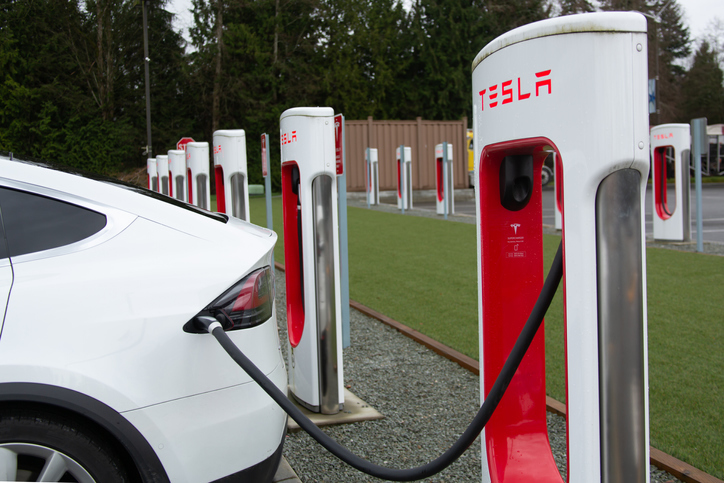
If the average life of a car is about 12 years, then that puts those 2035 model cars still on our highways until 2047!
What sounds reasonable at first blush is more likely to be yet another dangerous postponement of sober and effective atmospheric heat-reduction solutions.
Given how much human-released CO2 is already in the sky, those timelines are cynical at best.
It will take much more than only ramping up electric and Hydrogen vehicle production to make a real difference.
• |
There are four major factors a safe atmosphere demands: |
| 1. |
Insure that all new vehicles won't emit CO2. |
| 2. |
Insure that all new vehicles are also of a potent atmospheric CO2 capture design. |
| 3. |
Insure that all old non-CCC vehicles will be retrofitted with dual-purpose CO2 scrubbers to both remove skyborne CO2, and capture their own CO2 tail-pipe emissions. |
| 4. |
Insure that service stations deliver clean electricity for CCC-EV's, and non-Methane sourced Hydrogen for CCC-Fuel-Cell cars. Clean electricity here means: NOT sourced from the burning of fossil fuels. |
CCC's • Carbon Capture Cars provide a mighty incentive to rapidly retire all non-CCC cars at a rate that might far exceed the status quo. With governments, industry, and citizenry onboard, the call to change course will be heard loud and clear.
You won't just be going to a clean and green electric car—that's only half way there. You will be going one giant leap for humankind more—to a car that cleans the sky of its CO2 overload.
The auto industry could take the high road, and recognize they have the power to save our planet and civilization—and the generations to come—should scientists and engineers declare that CCC vehicles outfitted with CO2 Scrubbers are a viable agency for quickly reversing the Climate Emergency.
And, the industry would likely sell a lot of magnificent cars, trucks, buses and RV's in the process.
Internal combustion engine automobile pollution is killing us.
Particulate pollution of the air we breathe is dangerous and even deadly. Recent research at Harvard University indicates that the issue is getting worse, regardless of governmental standards put in place that were designed to regulate the issue. Thousands of lives could be saved—and health issues minimized—if we choose to deliberately move away from the gasoline engine, and embrace non-polluting models. HARVARD • UOCS
Carbon Capture Cars won't pollute.
Instead, they'll pluck Carbon Dioxide from the sky day and night.
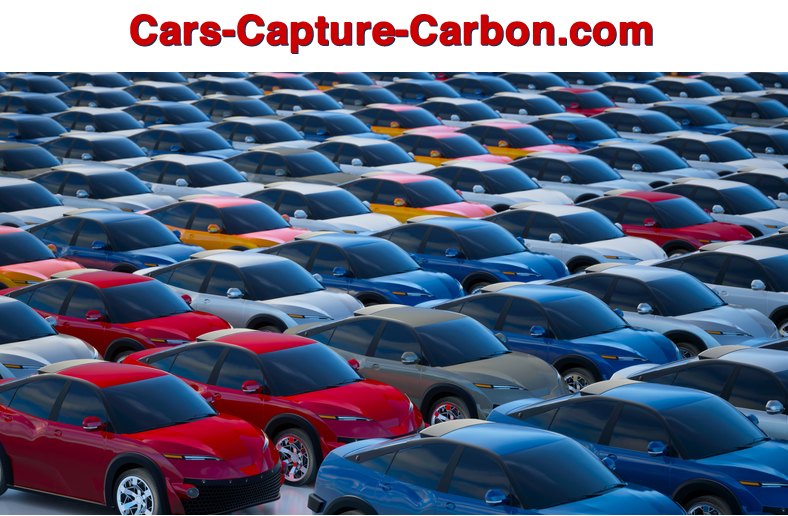
Our goal is to turn the fleet Green as fast as possible. That means
first and foremost
to convert production to pure CCC—no to emissions, and yes to on-board CO2 removal.
Let's open a second front and retrofit all vehicles currently on the road.
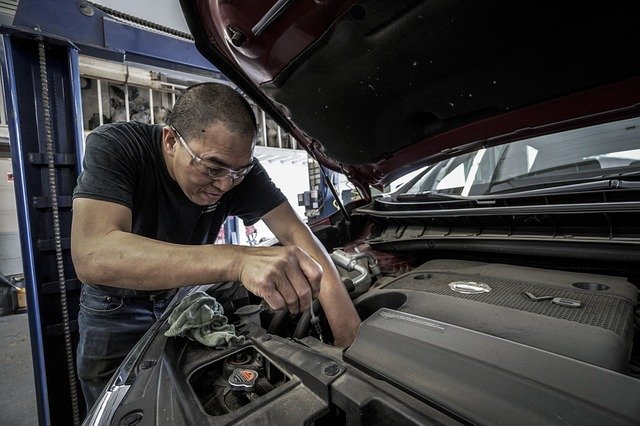 No, we won't penalize those who still drive a CO2 emitting vehicle. No one will have to choose between keeping their car on the road or being forced to buy a new Carbon Capture Car. No, we won't penalize those who still drive a CO2 emitting vehicle. No one will have to choose between keeping their car on the road or being forced to buy a new Carbon Capture Car.
To reduce anxiety and be fair to the millions of non-CCC vehicles, owners will be allowed to continue to drive their vehicle. However, they will all also be asked to adapt.
Image by Ryan Doka from Pixabay
Two for the price of one?
We will also ask that CO2 Scrubbers capture their own vehicle's Carbon Dioxide effluence.
Non-CCC cars, trucks and buses would then be performing two important tasks:
1) They would remove CO2 already in the atmosphere, and... 2) they would also be removing a healthy percentage of the CO2 they are generating from their burning of gasoline.
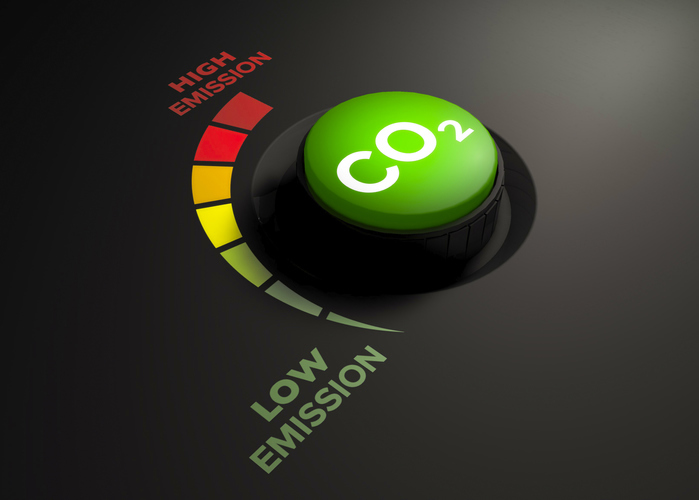 By law, and over the course of just a few years, any car brought in to any service station would automatically be retrofitted. Additionally, even if there was no pressing service requirement,
vehicle owners might still get a letter in the mail indicating: "It's your turn. Please bring your car into Max's Auto Garage on Oct. 12th." An entire new industry will be born—one whose purpose will be a one-two punch: the retrofitting of CO2 Scrubbers on polluting cars, and removing that dangerous Carbon Dioxide from both the sky and the vehicle's tailpipe. By law, and over the course of just a few years, any car brought in to any service station would automatically be retrofitted. Additionally, even if there was no pressing service requirement,
vehicle owners might still get a letter in the mail indicating: "It's your turn. Please bring your car into Max's Auto Garage on Oct. 12th." An entire new industry will be born—one whose purpose will be a one-two punch: the retrofitting of CO2 Scrubbers on polluting cars, and removing that dangerous Carbon Dioxide from both the sky and the vehicle's tailpipe.
Regulation would insure that all vehicles are retrofitted to conform with our clean atmosphere goal. These efforts applied to internal combustion engine vehicles would make a substantial difference in reducing vehicular CO2 pollution and would be a potent climate-cleaning initiative in their own right.
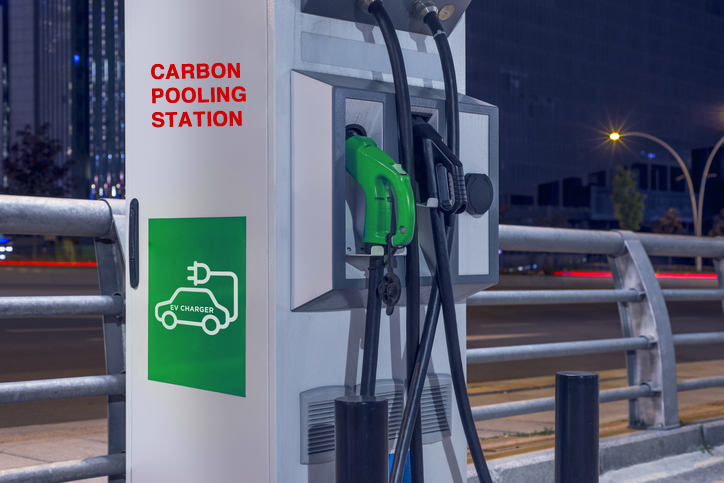
Image text translation: Carbon Pooling Station - Electric Vehicle Charger
EV CHARGERS / CARBON POOLING STATIONS •
NOW LOCATED IN CITY & COUNTRY,
EAST & WEST, AROUND THE CORNER & IN THE NEXT STATE OR PROVINCE OVER...
Your new Carbon Capture Car will capture CO2— and it will also regularly deliver it.
Carbon capture is difficult. It requires exotic designs to meaningfully remove CO2 from the atmosphere. That invention is now here, and may shortly be in your car. The second tier of Carbon capture is: "What do you do with the stuff once you've got it in the tank?"
This is the other remarkable point about using our vehicles for Carbon capture. They can capture it anywhere, but they can only deliver it to the same places we all will charge up at. This is the less obvious but altogether necessary activity that CCC vehicles perform.
All commercial refueling stations and chargepoints will by law be outfitted to accept volumes of CO2. On a regular time schedule, those enormous tanks of concentrated CO2 are trucked or piped away to sequestration facilities, and thus the circle is complete.
Could CCC vehicles be one of the keys to completely reverse Global Warming?
 As Carbon Dioxide builds in the atmosphere, it also acts like a blanket. Sunlight that strikes the Earth's surface creates heat. As that heat attempts to return to space, it is blocked by the presence of ever increasing amounts of greenhouse gases, of which the primary culprit is CO2. As Carbon Dioxide builds in the atmosphere, it also acts like a blanket. Sunlight that strikes the Earth's surface creates heat. As that heat attempts to return to space, it is blocked by the presence of ever increasing amounts of greenhouse gases, of which the primary culprit is CO2.
What is not widely known is that it only takes tiny amounts of CO2 increase to cause a disproportionate trapping of that heat trying to get back to space.
This might be very good news. What's causing the Global Warming crisis are just the small amounts of excess CO2 in any given volume of air. If we remove those small amounts, we could lower the temperature. Until recently, there was no easy way to do that—but that is now about to change. What's brand new are technologies which can remove CO2 from the atmosphere at any concentration. The fastest way to scale up that removal process would be to harness the monumental capacity of our global fleet of 1.5 billion vehicles on the road.
If we reduce the amount of CO2 in the atmosphere by a mere 130 ppm, we will achieve our goal. There are a billion cubic miles / 4.2 billion cubic kilometers of air encircling our globe.
The total CO2 reduction needed to completely return us to normal temperatures is only .015% of that vast ocean of air. That works out to about 150 thousand cubic miles / 625 thousand cubic kilometers of excess CO2, still a stunningly large volume.
Along with other CO2 removal technologies, that mountain of CO2 in the sky will still be no match for those billion and a half cars, trucks, RV's, buses, locomotives, big ocean-going ships—and with time, all the buildings in all the cities of our planet—draining their 'cube' of CO2 every week over a 30-year timeline. We don't have to look to exotic locales to make it right: we can use the vast infrastructure we already have. |
Carbon Capture Cars
Just imagine for one moment that all of these cars and trucks are capturing CO2
from
thin air—
rather than spewing it out and poisoning your precious atmosphere.

Imagine if all of our 1,500,000,000 cars, trucks, buses, locomotives,
big ships and even big city skyscrapers
the world over began
plucking
gigatons of CO2
right out of the sky, 24/7/365.
CO2 capture tanks on cars and trucks can capture and store
thousands of times the
amount of Carbon Dioxide found in an equivalent volume of ordinary air.
One single car alone can do that every week...
imagine one and one-half billion—with projections heading to two billion cars on the road in the next decade—doing it every week!
Though there are many real-world initiatives taking place today, and dedicated
to removing Carbon Dioxide from the sky—and are efforts we must support— there
is no platform that can match both the speed of inception, and the truly vast
potency and potential of converting our global automobile fleet to the task of CO2 capture.
CAN YOU IMAGINE JUST HOW POWERFUL AND POTENT A REMEDY
WE
WOULD HAVE
IN OUR HANDS
TO COMPLETELY REVERSE GLOBAL WARMING IN THE FASTEST TIMELINE POSSIBLE?
There is no Planet B. If we don't fix it here, and do it now,
we will have no future as a society, a species or a civilization.
|
| |
|
As vehicles transition from
CO2 polluters to CO2 gatherers,
with every passing year the rate of
atmospheric warming will slow; eventually our
atmosphere will reach a healthy tipping point
and our sky will begin to noticeably cool down. |
Let's look at the cost of fielding this audacious Climate Emergency solution.

The cost of CO2 Scrubbers can be spread across all of the consumers who use them—which will be just about everyone. Vehicle manufacturers will be on board hopefully for planet-saving reasons. They will also appreciate that every vehicle produced will now include another profit center: a Vehicular CO2 Capture and Storage Tank.
Some might justifiably challenge that model. "Manufacturers should do it as a public service. It is about saving our planet—isn't it?" While that's true, it just might be the better part of valor to incentivize their participation by making it profitable.
Up front, the lure for consumers might be the desire to make a difference. This spirit of the times could be nurtured with widespread public service announcements, as well as widely distributed talks by experts concerning the historic importance of the transition.
Governments will also offer significant incentives when a CCC car is purchased. For example, an affordable CCC vehicle could be coupled with a significant rebate from any country's treasury: "This new CCC vehicle will be sold sales-tax free; additionally, your government will assist you in defraying its cost with a $2500 rebate."
In order to insure a firm phase-out date for the manufacture of non-CCC vehicles, governments would have laws on the books mandating that manufacturers comply.
"Rather than make a more efficient fossil fuel-powered car (thermodynamic efficiency), or drive it less (behavior efficiency), it makes more sense to make an electric car powered by renewable energy." ELECTRIFY - SAUL GRIFFITH
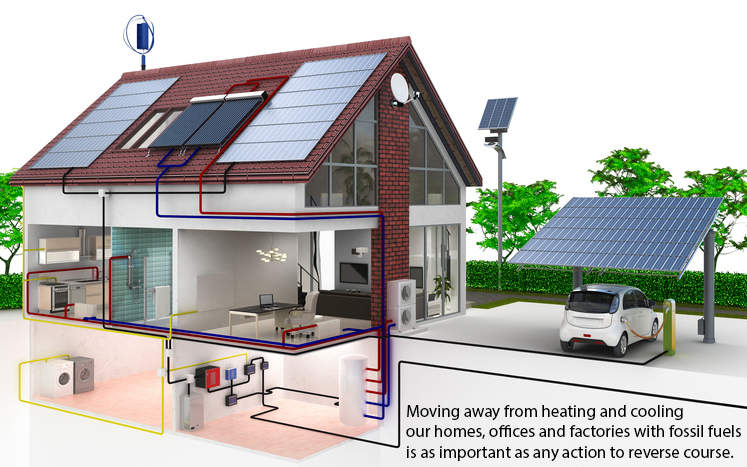
Image text translation: Moving away from heating and cooling our homes, offices and factories with fossil fuels is as important as any action to reverse course.
Some might say: "Let the market decide; it is what's always worked." The issue with that reasoning is that it does not take into account the extreme harm that is currently being done—and will continue to be done—by all the existing vehicles that rely on fossil fuel.

Competition in a new CO2 Scrubber manufacturing environment will insure that costs that will be passed on to the consumer will be reasonable. We might all pay a little bit more for that new car, but the financed payments will be spread over many years. We will be doing our part.
Say that a CO2 Scrubber retails for US $500, including the cost of installation in a vehicle. If that were a cost that had to be borne by governments, it might be regarded as outlandish: perhaps US $1 Trillion.
On the other hand, were it borne by the billion and a half consumers, it would just be another relatively small notch in their financed vehicle, and paid out over a period of years.
Given the seriousness of the Climate Emergency, this math is a reasonable way to parse an effective financing rubric for the removal of all the excess CO2 in the sky. It's also likely that governments might wish to participate in defraying those costs.
Tesla & The Moon Image by Ben Saida from Pixabay
It's a good approach when neither governments nor manufacturers will find an objection to a CO2-removing planet-saving enterprise. Research and development to perfect this new and exciting invention will still require funding by governments and manufacturers.
You've seen those movies where an ancient and dangerous asteroid is careening towards Earth.. and we only have a few years to plan, build a rocket, and launch a team of heroes into space to blast that primordial rock to smithereens.
The real-world movie is now happening... and the equivalent plan for our survival might just depend on unleashing the political will and the financial resources to counter the threat, and to enact historic legislation to reimagine our global automobile fleet.
A timeline to launch meaningful production quotas for Carbon Capture Cars can easily be achieved within five to ten years. The scale we need is at hand—let's put it to work.
|

Image by PIRO4D from Pixabay
30 years is a long time to scrub all the excess CO2... but consider the following:
With every passing year, excess atmospheric heat might be reduced by 3.3%.
"Excess atmospheric heat" is defined as the difference between the mean temperature of 150 years ago and the mean (average) temperature in 2022.
 Our global internal combustion engine auto fleet has been doing the exact opposite for well over a hundred years. Our global internal combustion engine auto fleet has been doing the exact opposite for well over a hundred years.
Image by kinkate from Pixabay
This is a simple model that does not take into consideration a myriad of variables. For example, the inability of governments to legislate other sources of Carbon pollution to net zero. Or, regarding the technology itself: the likelihood that CO2 Scrubbers—or parts of them—may have to be replaced occasionally as their charge/discharge cycle loses efficiency, similar to an air or oil filter that needs to be replaced from time to time.
With insight and innovation that we may not foresee in the present moment, other remedies may emerge to augment and hasten the development process—including advancements to the proposed CCC auto fleet to become more robust and efficient.
If CO2 is so dangerous, why do I want a tank of it in my car?
 Excess CO2 in our atmosphere is as dangerous a threat as one can imagine. It is the primary driver of Global Warming. However, CO2 is also one of the most benign gases there is. It is colorless, odorless, non-toxic, and non-combustible. Excess CO2 in our atmosphere is as dangerous a threat as one can imagine. It is the primary driver of Global Warming. However, CO2 is also one of the most benign gases there is. It is colorless, odorless, non-toxic, and non-combustible.
We breath small amounts of it in, and exhale large amounts. CO2 is in many ways the life-blood of nature.
There is no danger from a full tank of CO2 in our cars. If there were an accident, CO2 would not burst into flames nor would it poison anyone.
Cars are on the ground. How will they capture the CO2 high up in the air?
 CO2 in the atmosphere is typically a highly fluid gas. Even though vehicles are at ground level, CO2 continuously mixes with all other gases and tends to average its concentration. CO2 in the atmosphere is typically a highly fluid gas. Even though vehicles are at ground level, CO2 continuously mixes with all other gases and tends to average its concentration.
Higher concentrations tend to devolve to lower ones. We don't need to be high up to withdraw CO2 from the sky. It can be done anywhere. "Healthy Sky" Image by Marco Roosink from Pixabay
Here's a thought experiment for the fun of it. Seriously...
 As you drive around over the next week, take the time to say to yourself, just as if it were already true: As you drive around over the next week, take the time to say to yourself, just as if it were already true:
"That car is removing CO2 from the sky. That truck is yanking it out. That bus is drawing it in. That RV is gobbling it up. My goodness!—every vehicle I see on the road is vacuuming CO2 out of thin air and sending it packing."
The purpose of the experiment of course is for you to have an experience of the all-important scale of this proposed endeavor, and its planet-saving potential. Everywhere you look, around every corner, parked at every home, in city and country, all the world's vehicles have been transformed, and they really do intend to save our planet.
What is it in particular that gives
MegaScale Fire Drones
and CCC • Cars Capture Carbon Vehicles their planet-saving power?

Fire Drones and CCC Vehicles obtain their power to make an actual planet-saving difference in that they function as integral GLOBAL SYSTEMS.
'Integral' defined:
"Necessary to make a whole complete; essential or fundamental."
Their constituent units function individually, but their ability to achieve the fastest sequestration of CO2 possible is due to the relative ease of fielding these solutions on the broadest of platforms possible— and to do it all rapidly, comprehensively, and globally.
That is also why it will take every responsible nation to get onboard with the plan.
_______________________________________________________________________
Automobile manufacturers are currently fielding more electric and Hydrogen powered vehicles than ever before; this is a transition we can all support. It's also true that many 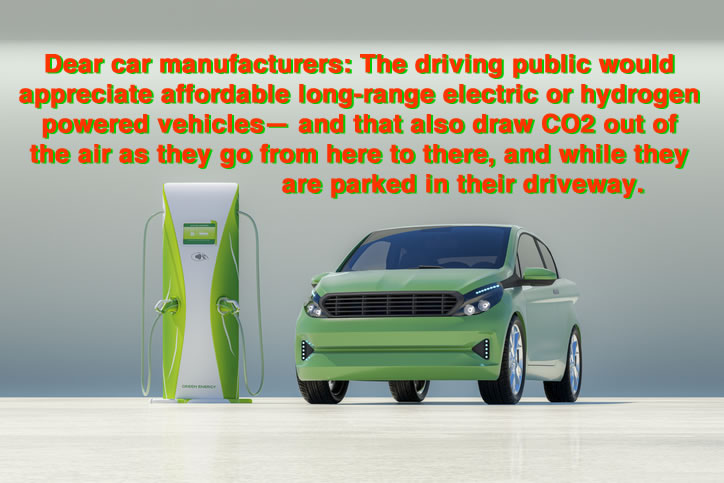 of the new EV models are too expensive for the average car buyer. Companies look at profitability; we can also request that they be sensitive to serious climate benchmarks. of the new EV models are too expensive for the average car buyer. Companies look at profitability; we can also request that they be sensitive to serious climate benchmarks.
Those benchmarks would include ramping up production targets for EV and H2 vehicles. They need to be affordable, offer significant increases in range—both now and as the technology improves—and also be designed to capture CO2 from the wind as they cruise the highways and byways in every country on Earth.
Imagine a near future where we meaningfully reverse all Global Warming dynamics.
What about trains, and ships at sea?
 There are over 100,000 locomotives and 54,000 large ships at work in the world today. Many of those locomotives and most of those ships rely on fossil fuel for their systems and propulsion. They all have plenty of room for CO2 Scrubbers. They could be adjacent to large holding tanks, and in the same way that an auto fleet would remove and consolidate CO2, so too would the world's locomotives and large ships. There are over 100,000 locomotives and 54,000 large ships at work in the world today. Many of those locomotives and most of those ships rely on fossil fuel for their systems and propulsion. They all have plenty of room for CO2 Scrubbers. They could be adjacent to large holding tanks, and in the same way that an auto fleet would remove and consolidate CO2, so too would the world's locomotives and large ships.
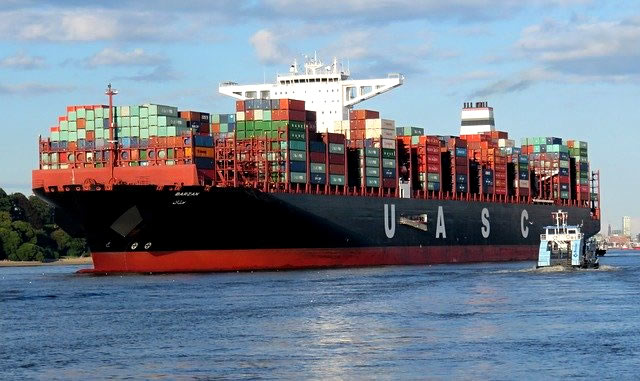 The model might even specify that they would remove twice the amount of CO2 they release into the atmosphere. In this way, they would remove the equivalent of their pollution, and go even further and remove an equal amount for everyone's benefit. The net result would be a practical method for an actual diminution of total atmospheric CO2. The model might even specify that they would remove twice the amount of CO2 they release into the atmosphere. In this way, they would remove the equivalent of their pollution, and go even further and remove an equal amount for everyone's benefit. The net result would be a practical method for an actual diminution of total atmospheric CO2.
Read about a similar proposal currently under consideration: NORTHWESTERN EDU
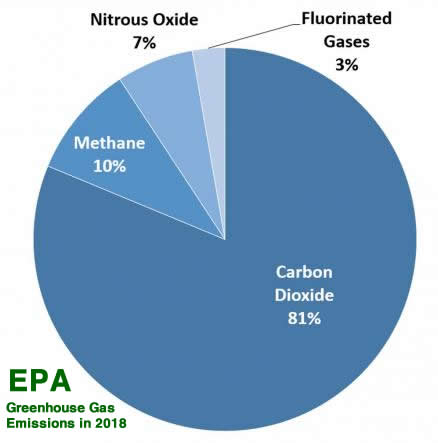
Could this technology be utilized to remove all the other excess greenhouse gases in our atmosphere?
Let's ask climate scientists and engineers to investigate if this or a similar technology could be designed and implemented to address this question.
The purpose would be to see if we could manage to remove all excess greenhouse gases across their spectrum.
The US Congress is proposing "allocating new sums to advance clean-energy technologies, including a $7.5 billion initiative for a first-ever national network of electric vehicle charging stations." August, 2021 - WAPO
Carbon Capture Cars or
Cars Capture Carbon??
Either way, CCC is win win!
—————> Our cars can save us. Whatever flag you salute, you can make it your business to ask your elected representatives, your government, and your news media to investigate
the potential of converting every single vehicle in your country to one that can
scrub the sky clean of all excess Carbon Dioxide.

—————> If you will do that, and your nation does that, and all nations do that, then we can guarantee a bright and safe future for everyone.
• CO2 Scrubbers are real, and they exist now.
• They eject a stream of pure Carbon Dioxide.
• The whole system operates at room temperature and normal air pressure.
This remarkable innovation has shown up at just the right time. It's possible it has the potential to single-handedly quell the Climate Emergency. The really good news is that the technology is in its infancy. With unlimited support given to the inventors and their company, every aspect of the already capable and potent apparatus might be improved: Made more efficient, crafted to be more robust, designed to handle more cycles, and optimized in every way possible. Hundreds of automobile manufacturing facilities as well as general-purpose production factories can be quickly outfitted throughout the globe.
Though the researchers are not yet focused on investigating the potential of small-scale yet high-powered CO2 Scrubbers for vehicles, as their tech becomes more robust, perhaps they will.
Scientifically speaking, CO2 Scrubbers are actually considered a type of battery.
From Science Daily, and edited for brevity:
 "The electrodes have a natural affinity for Carbon Dioxide and readily react with its molecules in the airstream, even when it is present at very low concentrations. "The electrodes have a natural affinity for Carbon Dioxide and readily react with its molecules in the airstream, even when it is present at very low concentrations.
The reverse reaction takes place when the battery is discharged -- during which the device can provide part of the power needed for the whole system -- and in the process ejects a stream of pure Carbon Dioxide. The whole system operates at room temperature and normal air pressure.
The system could always be both capturing and discharging  the gas. In the lab, the team has proven the system can withstand at least 7,000 charging-discharging cycles, with a 30 percent loss in efficiency over that time. The researchers estimate that they can readily improve that to 20,000 to 50,000 cycles." SCIENCE DAILY and PUBS RSC the gas. In the lab, the team has proven the system can withstand at least 7,000 charging-discharging cycles, with a 30 percent loss in efficiency over that time. The researchers estimate that they can readily improve that to 20,000 to 50,000 cycles." SCIENCE DAILY and PUBS RSC
“Combating climate change requires the world to prevent further increases in atmospheric carbon dioxide concentrations and eventually return them to pre-industrial levels,” according to Dr. Brian Baynes, Founder and CEO of Verdox. “Many industries, however, still lack a plan for complete decarbonization, because of the high cost and energy consumption of currently available capture technologies. Unlike these predecessors, Verdox’s technology has the potential to capture carbon from any industrial source or the air – and at up to 70% relative energy savings, giving us the ability to intervene completely.” ENERGY POST
From the inventors' 2019 published research paper:
"Faradaic electro-swing reactive adsorption for CO2 capture."
"There is a clear scientific consensus on the role of anthropogenic greenhouse gas (GHG) emissions in the unusually wild fluctuations of global climate patterns over the last  century, to which Carbon Dioxide is the largest contributor. century, to which Carbon Dioxide is the largest contributor.
This has generated a scientific tide in the study of Carbon removal techniques over the last three decades, which has slowly gathered momentum, culminating in the 2015 Paris Agreement, which heavily emphasized the role of Carbon removal by tackling emissions or via negative emissions technologies.
While a path forward for Carbon capture is being shaped by a mix of incumbent actors and newcomers, the great majority of the proposed processes rely on conventional concepts. Moreover, most of these processes have a large balance of plant which hinders their potential to flexibly adapt to the multi-scale nature of Carbon capture.
Herein, we demonstrate a new approach which presents a paradigm shift in adsorption type processes and Carbon capture. The electro-swing basis of our process allows its linear scaling with desired capacity and lends it geometric flexibility. It also allows Carbon capture from streams of any concentration, and its release into any carrier streams, including pure CO2, with a low balance of plant." INVENTORS' PUBLISHED WORK
Important note: The researchers and developers of these breakthrough techniques and scientific methods have neither endorsed—nor objected to—the possible purposes that might be considered for their invention, such as those referring to the text herein, for example, that their novel technology might be adapted for use in all the world's automobiles in order to rapidly remove historically significant amounts of Carbon Dioxide from our atmosphere, as well as in the many other colorful climate-oriented possibilites and examples posited in this presentation.
|
CCC's = Carbon Capture Cars
• CCC / Carbon Capture Cars won't pollute.
• They will instead remove billions of tons of CO2 from thin air every year.
This formula is similar to other plans for direct capture of CO2.
What sets it apart are seven critical breakthrough distinctions: |
1
A big
number.
|
The unprecedented number of continuously active 'machines' we will commit to accomplish our goal:
All the world's cars, trucks, buses, ships and locomotives.
This solution to the Climate Emergency proposes the largest-scale measures ever contemplated for any technical remedy designed to quickly cool the planet.
Vehicle owners will forget all about the CO2 capture tanks on their car's undercarriage. The continuous removal and sequestration process will take place automatically—out of sight—and out of mind.
The technique will quickly become universally accepted, and considered to be obvious, ordinary and mundane.
And, it is the simplest method to implement globally:
Though there are a lot of vehicles produced every year, there are only about 650 factories worldwide producing them. Those factories exist, function and.. produce now.
If they are all quickly outfitted to add CO2 Scrubber installers to their production lines, that's all it will take to largely reverse the course of the Climate Emergency.
The engineering and physical plant costs to accomplish this are miniscule and even trivial, compared to any other global atmospheric Carbon Dioxide removal plan.
Intense and rapid timelines for implementation guarantee major climate amelioration benefits, making this plan both straightforward and compelling.
|
2
Raw speed.
 |
The raw speed of implementation: within five years we can insure that every car factory is outfitted to produce CO2 Scrubbers and install them in all vehicles on their production lines. The process would be as ordinary as any other component to be installed on the line.
Raw speed comes from not reinventing the wheel.
Existing roads and highways—64 million miles of them— provide the 'launchpad' for scrubber-equipped cars.
Existing financing from lenders and stock purchases fund both the transition and its ongoing sustainability.
Existing purchasing pipelines order and distribute all requisite pre-production materials.
Existing automobile factories will access existing abundant reliable energy sources as they always have.
A necessary evil would be required: The utilization of fossil-fuel and nuclear power sources— at least at first.
An existing marketing team will declare its product to be not only sleek and full of creature comforts, but that it will also be a vehicle its owner can be proud of as it does its part to cool the planet. That pitch alone will offer one more incentive for the motoring public to buy one.
An existing top-notch automobile workforce and management gets it all done.
Existing gas/petrol stations will convert to electric and Hydrogen to charge and replenish vehicles, as well as to remove the CO2 in their holding tanks for sequestration.
No new factories, installations or land, no new materials acquisition base, no new energy sources and no new management, workforce or sales team are required.
|
3
Low cost.
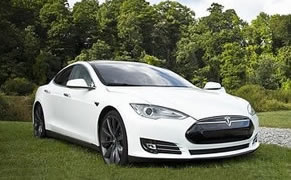
|
The extremely low cost relative to any other sustainable plan: everyone with a driver's license helps pick up the tab. Industry and government contribute as well, and make sure that cost, efficacy and safety are regulated.
Financing would readily flow to automobile manufacturers to fund their retooling both to electric/Hydrogen vehicles and to the engineering to produce and install CO2 Scrubbers.
Lenders will appreciate the potential. Warranties for consumers would ease concerns, and insurance would fix or replace Scrubbers should any become damaged.
|
4
We're all in.
 |
Everyone can participate in making this work.
People in every corner of the globe are invited to step-up and support this plan. Public endorsement would be a clear message that new priorities are imperative.
Companies and their customers—as well as legislatures and their constituents—will ask that we invest in and produce working prototypes as an urgent priority.
As millions of new Carbon Capture Car models emerge from factories, drivers would care for their cars as they always have.
With citizens, auto manufacturers and governments on board, a true alliance for action can be launched.
|
5
A fast transition.
 |
We can substantially accelerate the transitioning of cars and other vehicles from being CO2 polluters to their new life as CO2 sequesters. In 2021 and 2022, auto manufacturers have been introducing new electric vehicle models at a greater rate than ever before.
As laudable as that is, it becomes an order of magnitude more auspicious if we insure that those vehicles are equipped to continuously remove excess atmospheric CO2 as they travel the world's roads and highways.
Nations will begin to ramp up the timelines for CCC vehicle production. Carbon Capture Cars—with their unprecedented breakthrough promise to reverse Climate Change—will thrust the issue to the forefront.
Rapid design changes and improvements will emerge, and be easily incorporated into the production process.
Even if we don't achieve a 100% result in the next three decades, we will certainly have reversed the trajectory.
Along with other large scale remedies, and government initiatives to reverse course, a cooling rather than warming atmosphere would be both a major achievement as well as a deep sigh of relief for us all.
|
6
Global reach.
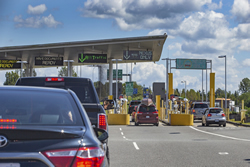 |
The cross-border and worldwide nature of the plan:
Cars and trucks are an international business.
If several large nations go this route, manufacturers may insist that every country accept the new class of CCC cars, trucks, buses and RV's, in order to keep their production costs low and maintain their profitability.
|
7
CO2 is
bad news.
 |
Nations and corporations with investments in fossil fuel infrastructure and sales of coal, oil and gas may wish to come onboard as they realize that the politics of Carbon has changed forever and the 'Carbon Age' is over.
In addition to scientists and activists, it will be up to ordinary folks everywhere to raise their voices so that corporations and governments understand it is time to disengage from Greenhouse Gas pollution now.
The facts concerning the Climate Emergency can inspire governments that Scale, Spend and Urgency can now become the number one priority of their agenda.
All burning produces unwelcome new atmospheric CO2. Though it seems a tall order, the roadmap is clear: we need to stop burning 95% of whatever makes new CO2.
Removing excess atmospheric CO2 is critical. Of equal importance is a drastic reduction in the CO2 pollution that takes place every day on our Big Blue Marble.
The knowing in our heart that we are the masters of our fate was never more true nor needed than at this moment of crisis. We can grant ourselves permission to be passionate about our efforts. |
Our children and our future.
When we say 'machines', it is to give those Carbon Capture Cars, RV's, trucks and buses an alternate and meaningful context. We see our vehicles as a means of transportation.
We will now also see them as one of the primary systems for launching the largest scale and fastest time-frame global CO2 removal strategy possible—hand in hand with that other most urgent priority of planting  vast new forests and globally deploying MegaScale Fire Drones to protect what is planted. vast new forests and globally deploying MegaScale Fire Drones to protect what is planted.
It's plausible that the number of new vehicles on the road may increase over time, which would only increase the rate of CO2 extraction. Without CCC tech on the job, we would be adding more CO2 in the sky, and making the prospects for a clean future that much more unlikely.
Sequestration on the grandest of scales is also necessary to handle the endless stream of gigatons of CO2 that will be captured from the atmosphere. The challenge of that design is formidable. Yet, it is a good problem to have... it means we've got the CO2 in the tank. For a good example, see WAPO
There is a certain poetic justice to the conversion. The very cars and trucks that have been profoundly poisoning our sky will now become the saviors of our civilization.
This is a campaign everyone and every nation can participate in, and take pride in:
the restoration of a clean global atmosphere and ocean, and the renewal of our planet. Everyone has a stake in lowering the temperature, and each of us might have an experience of satisfaction as we clean the atmosphere for our children and our future. |
|
CARS CAPTURE CARBON
Would Carbon Capture Cars (CCC's) —
removing
billions of tons of CO2 every year
— actually work??
|
 |
Let's have scientists and engineers weigh in on the matter. If there's an indication that CCC cars might work, let's build a prototype, put it on the road, and extrapolate what 1.5 billion vehicles might do.
If there's a sense that this technology might in fact have a beneficial part to play, then let's improve it, invest in it and field it.
If there's no positive result, we can say we did our best and put our focus elsewhere. We will learn useful data even if we fail. |
|
|
The Scion Electric Car
See what SONO is doing to build a car that literally runs on sunlight, and also fully re-charges at chargepoints when necessary in about a half hour.
Click the pic... |
|
|
|
Direct Air Capture of CO2 offers unlimited safe storage
7,000 feet / 2,140 meters deep underground.
Can we scale it up?
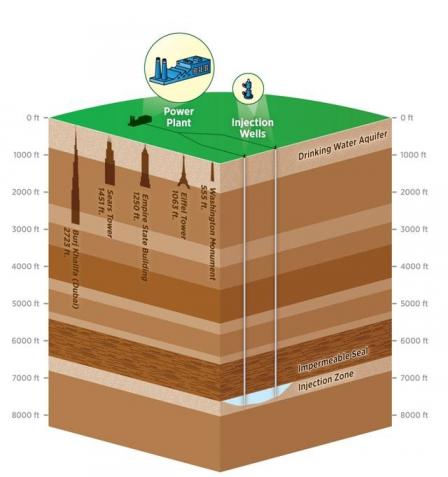 Image text translation: Power Plant. Injection Wells. Drinking Water Aquifer. Impermeable Seal. Injection Zone. Burj Khalifa, Dubai. Sears Tower. Empire State Building. Eiffel Tower. Washington Monument. Image text translation: Power Plant. Injection Wells. Drinking Water Aquifer. Impermeable Seal. Injection Zone. Burj Khalifa, Dubai. Sears Tower. Empire State Building. Eiffel Tower. Washington Monument.
Carbon Dioxide Capture & Sequestration
...or simply "CCS" via deep underground injection is an established method for removing CO2 from the atmosphere. It is also about to become extraordinarily more efficient with the addition of CO2 Scrubbers at all the appropriate geological sequestration points.
|
CCS is the current gold standard for storing captured CO2. It involves vacuuming CO2 at point sources, such as power plants and factories, transporting it over distances, mostly via pipelines, and delivering it to facilities designed to put that CO2 permanently below ground.
However, with the new CO2 direct-air capture devices now coming on line, CO2 density is no longer an issue. Atmospheric extraction can take place anywhere. This will allow CO2 to be removed at the most effective geologic points for underground sequestration—and no longer necessarily or only at fossil fuel power plants or like facilities.
The capacity in injection zones at depths of 7,000 feet below the surface is enormous:
"The U.S. Department of Energy estimates that anywhere from 1,800 to 20,000 billion metric tons of CO2 could be stored underground in the United States. NACAP
That is equivalent to 600 to 6,700 years of current level emissions from large stationary sources in the United States." EPA
CCS facilities use CO2 for EOR: 'Enhanced Oil Recovery.' The jury is still out on whether or not this is a good thing. What is interesting is that EOR is currently the most successful extractor of atmospheric CO2. VOX |
|
|
|
Desert Solar Panel installations can
be fielded at lightning speed. Why not commit
to a ten-fold yearly increase in implementation?
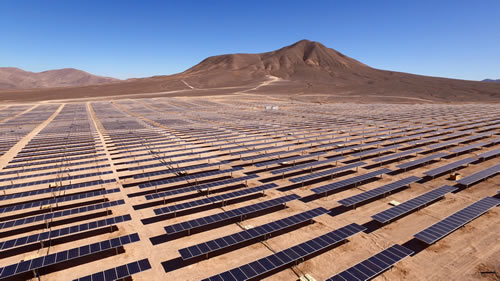
Photo by Antonio Garcia on Unsplash • Direct conversion of solar to electricity.
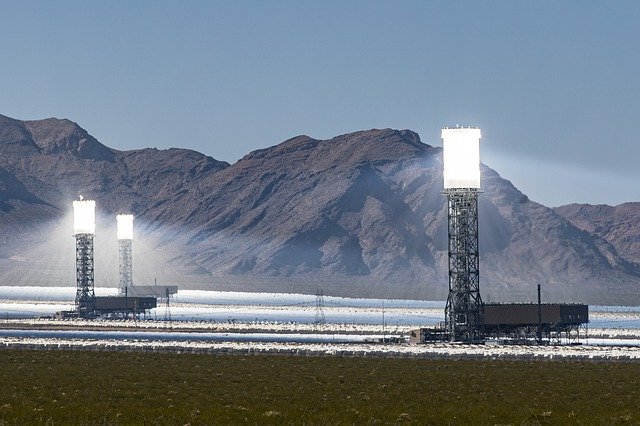
Image by Michael4Wien from Pixabay • Solar thermal steam turbines = electricity.
|
Hundreds of new installations such as the two pictured here would utilize only a tiny fraction of the planet's 6.6% of arid desert land area. That 6.6% is an unimaginably vast 3.8 million square miles / 9.8 million square kilometers — the size of the entire USA.
In other words, building out extensive desert solar installations — in order to completely replace fossil fuel power generation — will harness an extremely small percentage of the available global dry desert real estate.
Due to increased production, solar power is becoming less expensive every year. Solar panels today are long-lived and practically indestructible. They've been around for a long time and the track record is impeccable.
There are few downsides to solar installations. Some feel they are an eyesore. There are concerns about the lead and cadmium used in their manufacture. Still, the consensus of good is 99 to 1. There's never been an oil spill in a solar or wind facility.
With political will, this technology can be ramped up quickly. MIT solar tech might be utilized, which would reduce the needed desert area by orders of magnitude, or if we kept the same scale, increase the clean energy production by orders of magnitude.
They can be engineered such that the life and inhabitants of the desert are not greatly affected. Each new installation allows for a decommissioning of a fossil fuel facility.
Not afraid to think big, Elon Musk "told a meeting of American state governors that the country could meet all its energy needs with a solar installation measuring 100 miles by 100 miles. A battery storage system, to enable 24-hour power delivery, would measure a further one mile by one mile."
JULY 2017 • INVERSE
If you took that statement seriously, and divided the implementation among 50 US States and 10 Canadian Provinces, it would work out to each one committing to a mere two square miles of solar panel installations. Comparison: Manhattan is 23 square miles.
Take a look at what CUBIC-PV™ is doing to create a next-generation solar panel "able to boost power output of modules by 30%."
|
|
|
|
Mass produce millions of CO2 Storage Silos.
CO2 can be removed from the sky right there in the desert.
Sequestration Silos could be mass produced and put in place by the hundreds of thousands yearly. They could be outfitted with rooftop Carbon removal devices.
They obtain all the clean electric power they will ever require from solar emplacements on top of or adjacent to their silos.
Most might be situated in distant deserts. Private land will not be disturbed, no eyesores will bother residents, and eminent domain will secure all the necessary desert required.
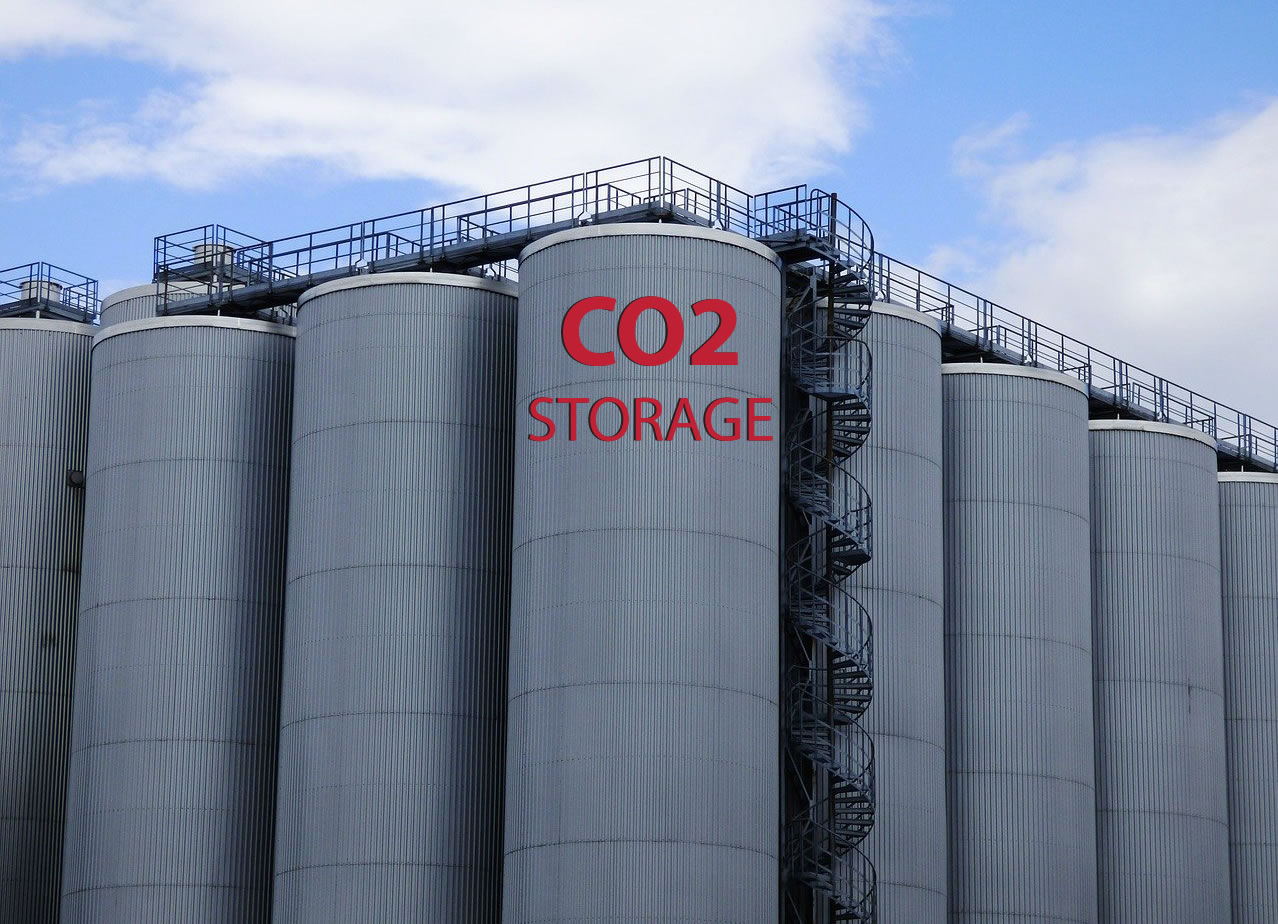
CO2 Storage • Image by Tomasz Mikolajczyk from Pixabay
This solution may be as expensive as all the aircraft produced in WWII—but as with all potent climate remedies, considerably less expensive than doing nothing at all.
Put as many super-size solutions in the field, let's do it now, and don't look back. |
Would CO2 sequestration be an effective remedy if we chose to store it in millions of CO2 Silos purpose-built to store as much excess CO2 as can be removed from the sky?
CO2 removal was once considered to be most effective where the concentration of it was greatest—i.e., at point sources such as power plants. New technologies can now remove CO2 from the atmosphere anywhere on Earth—and at any concentration.
As the technology improves, CO2 might be combined with inert substances and gainfully utilized, for example, as building materials. Implementing methods to ramp up CO2 sequestration infrastructure are needed.
Scale is the operative principle here: If you were not concerned with CO2 transport or underground injection, you could perhaps scale up non-mobile efforts to remove CO2 from the atmosphere at dynamic rates—rates sufficient to reverse Global Warming within a brief period of time.
Carbon (C) Silos—as contrasted with Carbon Dioxide (CO2) Silos—will make more efficient use of any given silo in terms of the volume of Carbon stored. Carbon is something you can weigh on a scale. It is much denser than gaseous Carbon Dioxide.
CCS underground injection, 'CO2 Silos', or Carbon only 'C Silos,' Fire Drones, CCC cars, trucks and ships—and other large scale initiatives—can all be on the same team.
Tens of thousands of trained and dedicated personnel could deploy millions of Sequestration Silos on six continents. |
|
|
|
Split CO2 and completely alter
the trajectory of the Climate Emergency?
If CO2 could be split, then the Oxygen component would be released into the atmosphere, and the Carbon component—now a 'solid,' and no longer a gas—could be sequestered or perhaps even utilized in other safe ways.
CO2 |
Excited
CO2 |
Splits to Carbon
& Oxygen |
 |
laser, UC Davis (University of California, Davis) Research to split CO2.
Excited CO2, C + O2 Products.
The exciting and exotic splitting of CO2 into benign Carbon and Oxygen is a technology worth investigation and scientific scrutiny.
Learn more about this bold possibility. |
 Sequestration Silos could receive the Carbon, while the Oxygen component would simply be released into the sky. Sequestration Silos could receive the Carbon, while the Oxygen component would simply be released into the sky.
If a Sequestration Silo was utilized to store that Carbon, it would then hold a much higher density of Carbon than CO2.
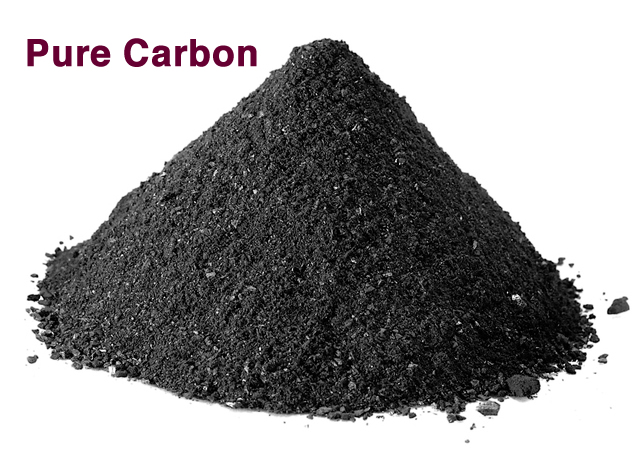 Such a methodology would be a far more efficient use of a silo's volume. Carbon in a silo might be a temporary stay—or perhaps not needed at all. Methods might be developed to gainfully use it in various applications, and perhaps even build Carbon hills covered with sand in deserts, or with soil to build out new forests in appropriate areas. Such a methodology would be a far more efficient use of a silo's volume. Carbon in a silo might be a temporary stay—or perhaps not needed at all. Methods might be developed to gainfully use it in various applications, and perhaps even build Carbon hills covered with sand in deserts, or with soil to build out new forests in appropriate areas.
|
|
|
 |
Here's a new smart car that's able to harvest sunlight as it soars down the highway.
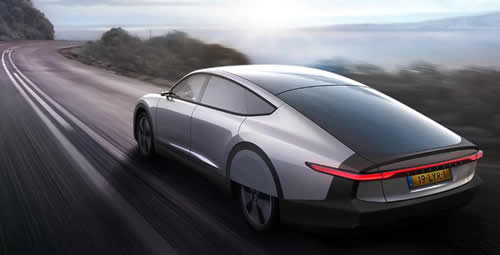 The Lightyear One is a car about to go into production. The company states a range of 725 kilometers / 450 miles on a single charge. The Lightyear One is a car about to go into production. The company states a range of 725 kilometers / 450 miles on a single charge.
Amazingly, it charges while parked or barreling along—provided the sun is shining. It obtains 12 kilometers / 7.5 miles of range per hour from sunlight alone. Real smart, and might end range anxiety too.
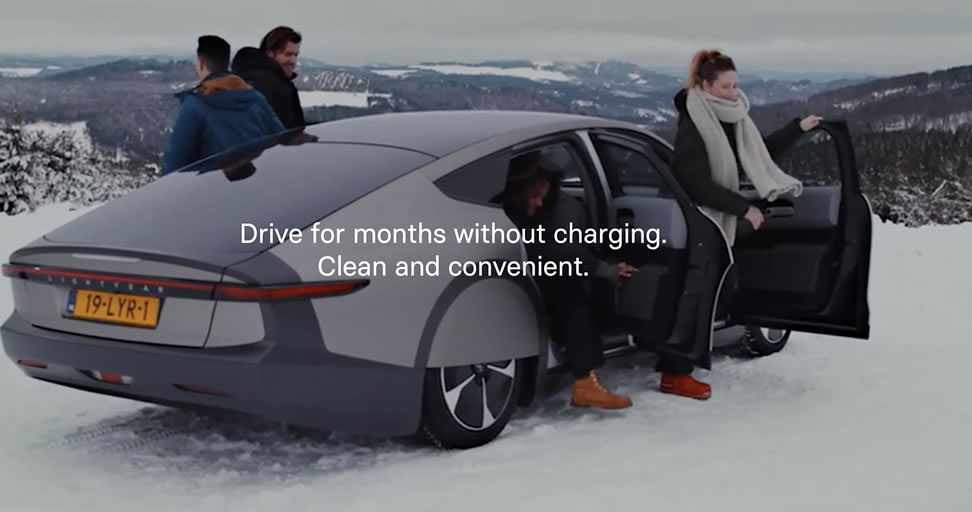
|
|
 Shanghai Skyline
Shanghai Skyline |
| |
By now, you are probably asking yourself:
"Hey! Why not ask every building in every city in every country in the world to start plucking Carbon Dioxide out of the sky, just like all of our cars are being asked to do??"
It's a great question, and the answer is simple:
It's something we must do as fast as we can. |
|
 Dubai Skyline
Dubai Skyline |
| |
All buildings, especially those which are very large and tall, are ideal facilities to engage in CO2 removal from the atmosphere. Unlike the CO2 Scrubbers affixed to vehicles, those on the rooftops or carve-out floors designated solely for carbon capture will be industrial strength. They will be much larger, more powerful and more productive than those fitted on CCC cars.
Building-captured CO2 would be transported through standardized conduits conforming to regulated safety and efficacy standards. Every building thus outfitted would then feed its catch into larger purpose-built underground municipal conduits.
They might utilize electrical pathways or piping through subway systems to deliver their CO2 to sequestration injection facilities, locking that CO2 deep underground for thousands of years to come.
As the old saying goes: "Only two things are certain— death and taxes." To that brief list we can add 'CO2 Scrubbers.' |
|
 Manhattan Skyline
Manhattan Skyline |
| |
CO2 Capture outfitted buildings will have two goals:
1) To at least equal or at best double their capture of excess atmospheric CO2 in order to offset their carbon footprint for heating, cooling and any non-Green electrification of their building.
2) To gradually eliminate their carbon footprint entirely, by producing heating, cooling, and electricity generation from non-carbon sources, yet continuing to maintain a robust, healthy and much needed CO2 capture regimen for decades to come.
__________________________________________
Why is large building CO2 removal in second place behind fielding a billion and a half CCC cars?
Re-imagining all of our vehicles to continuously extract skyborne CO2 is much simpler to implement and ramp up than is tasking our disparate buildings in cities all over the world to get on board.
Buildings once built are static, and ownership is in the hands of thousands of different organizations.
On the other hand, vehicles can easily be climate-engineered at specific factories the world over. The number of those factories is the tiniest of fractions compared to the number of large city buildings. To get global CO2 removal up-and-running, the first and primary method of choice is to focus on our vehicles.
Yet, since the game plan for our survival is the removal of all excess CO2 in the sky, then every large-scale remedy we can implement is worthy of our consideration, our treasure, and our respect. |
|
| |
|
|
|
|
|
|
Phase out dangerous technologies.
Ramp up green technologies.
|

Image by Gerhard Gellinger from Pixabay
Atmospheric CO2 overload is tied
to outmoded legacy technologies.
The oil and gas industries, the automobile industry, and industry more generally, all still rely heavily on CO2-generating technologies such as gas, oil or coal power plants, the internal combustion engine and the global building heating markets.
Polluting industries wield power and influence in the halls of Congress and Parliaments everywhere.
As unbelievable as it sounds — given all we now know about the perils of Climate Change — nations pursue ever greater amounts of oil and gas extraction wherever they can. They drill in the Arctic, in the Gulf of Mexico, and in oil fields everywhere. NY TIMES
We may experience our complicity as we use their products—and feel powerless to request green solutions—even though more such remedies are available today than ever before.
Progress is being made: "Momentum is shifting toward a clean-car future as more automakers end their legal efforts to block California’s tough fuel economy standards." NY TIMES
Planning in both directions is vital: We need to scale up climate saving technologies—and at the same time — scale down the CO2 spewing technologies at an equal rate.
___________________________________
Some folks think wind turbines are unsightly.
It's all relative though...
|
Make wise choices while we still can.
As we continue to extract and burn fossil fuels—as a direct consequence of their demand—we are endangering our near-term future.
Alternatives exist and consideration might be given to replace all CO2 emitting tech with clean energy sources. Establishing a sunset date statute might galvanize large companies to rapidly plan their transitions to renewables.
The Green New Deal in the United States is one such proposal comprehensively addressing the issue, and it could be a model for the world.
THE GREEN NEW DEAL • US CONGRESS
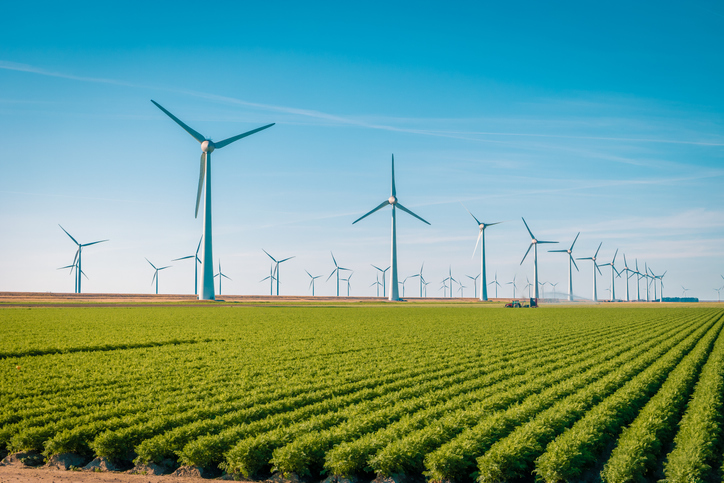
Wind turbines produce prodigious amounts of clean energy.
The bad news is that even if we stopped putting CO2 in the sky tomorrow — without also removing the excess — our atmosphere would continue to warm for many years to come, perhaps decades. EARTH.ORG
The good news is that by assertively ending CO2 pollution, and beginning to embrace planet-scale measures to remove all excess CO2 from our atmosphere, temperatures will inexorably and significantly begin to fall.
It is essential that we be willing to design and implement extraordinary works on the largest of scales, coupled with a willingness to spend.
Proposals such as unlimited reforestation, MegaScale Fire Drones, and turning all cars on the road into CO2 extractors deserve serious investigation regarding their feasibility and potential. Should they be green-lighted, turning those ideas into reality without delay is critical.
If we could implement enough vast scale solutions, we will assuredly and confidently be able to bring global temperatures down and eventually reach 1960 levels within decades.
Yet, there is no reason to stop there—we can go further, to pre-industrial levels. That will go a long way to restoring a balanced atmosphere, and insuring we do no further harm. We can begin now to do what is necessary to achieve those goals. |
|
|
|
 |
|